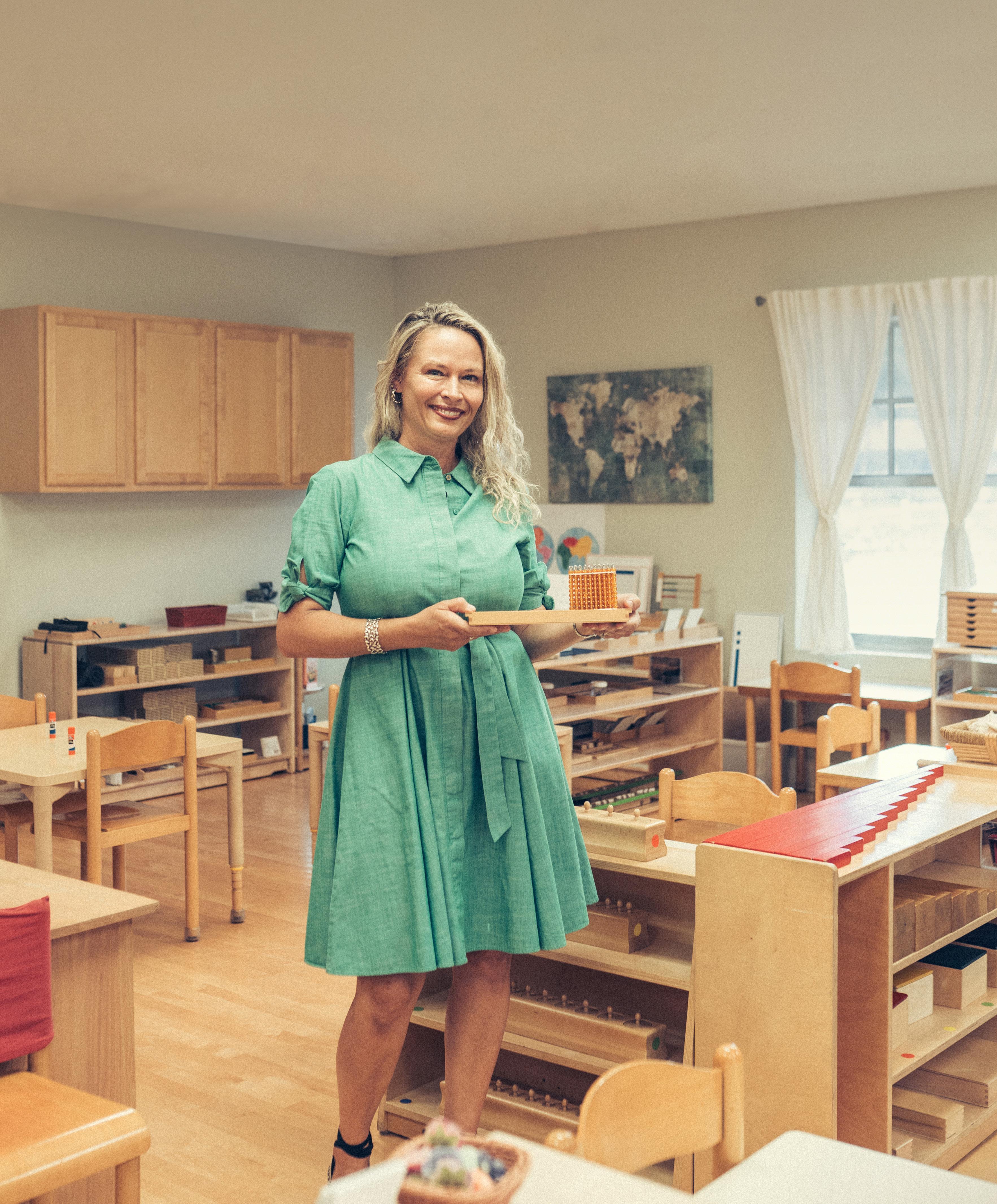
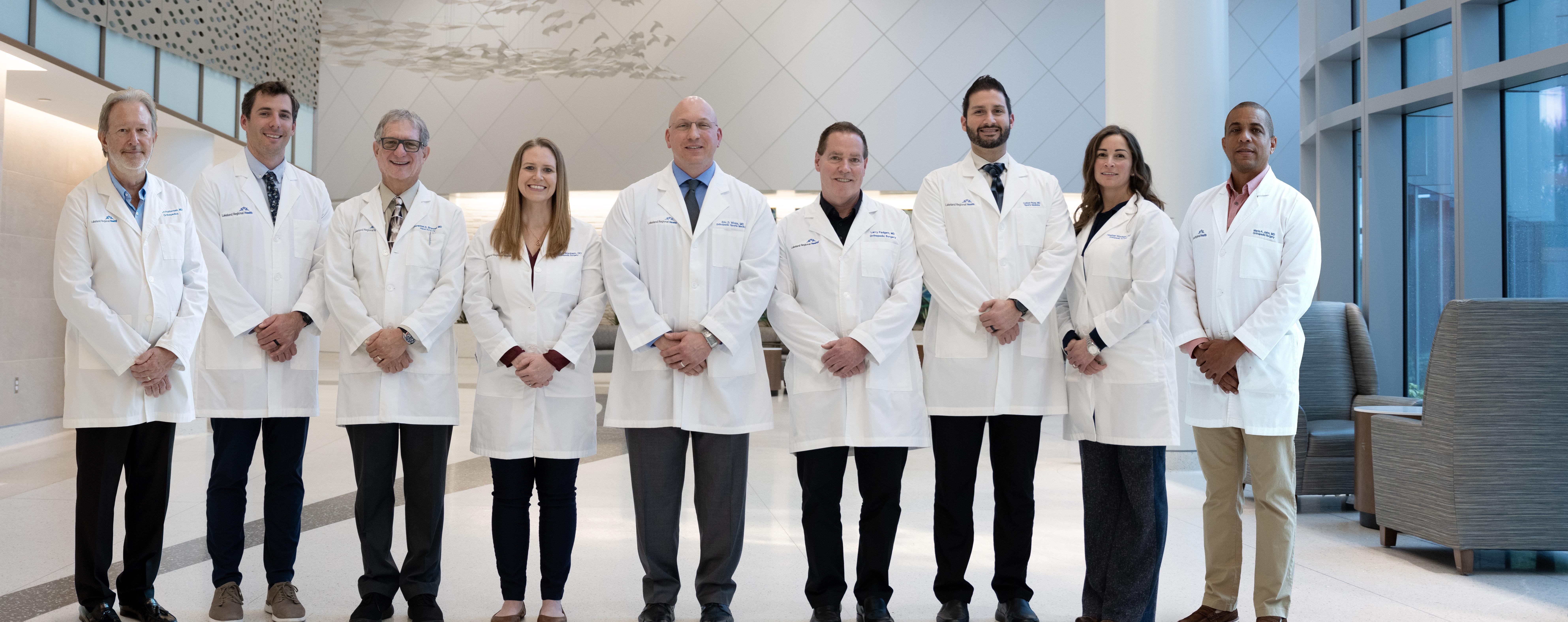



You were made to keep moving. So when pain slows you down … that’s where we come in.
Our expert orthopedic physicians offer care in a wide range of specialties using advanced surgical procedures, leading-edge technology, innovative solutions, and individualized treatment plans.
Your Health. Our Promise.


To learn more about the expert orthopedic care offered by Lakeland Regional Health Physician Group, call 863.284.6784 or visit myLRH.org/LRHPGOrtho.
Orthopedic Services
Sports Medicine
Total Joint Replacement (Hip & Knee)
Shoulder and Elbow
Hand and Wrist
Foot and Ankle
Pediatric Care
Trauma
How to use a QR code:
1. Open your smartphone’s camera.
2. Hold it over the QR code.
3. Click on the link that pops up.


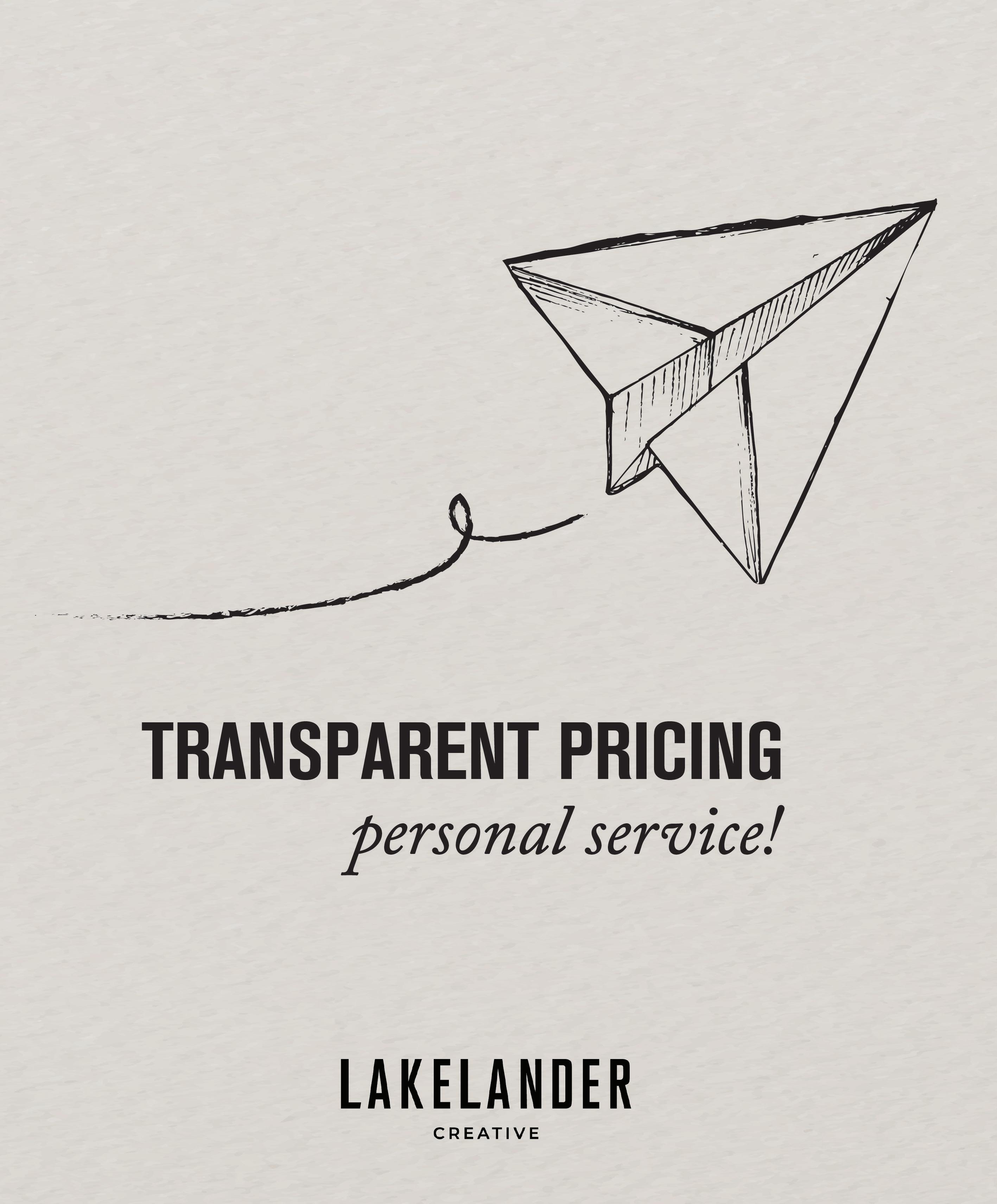
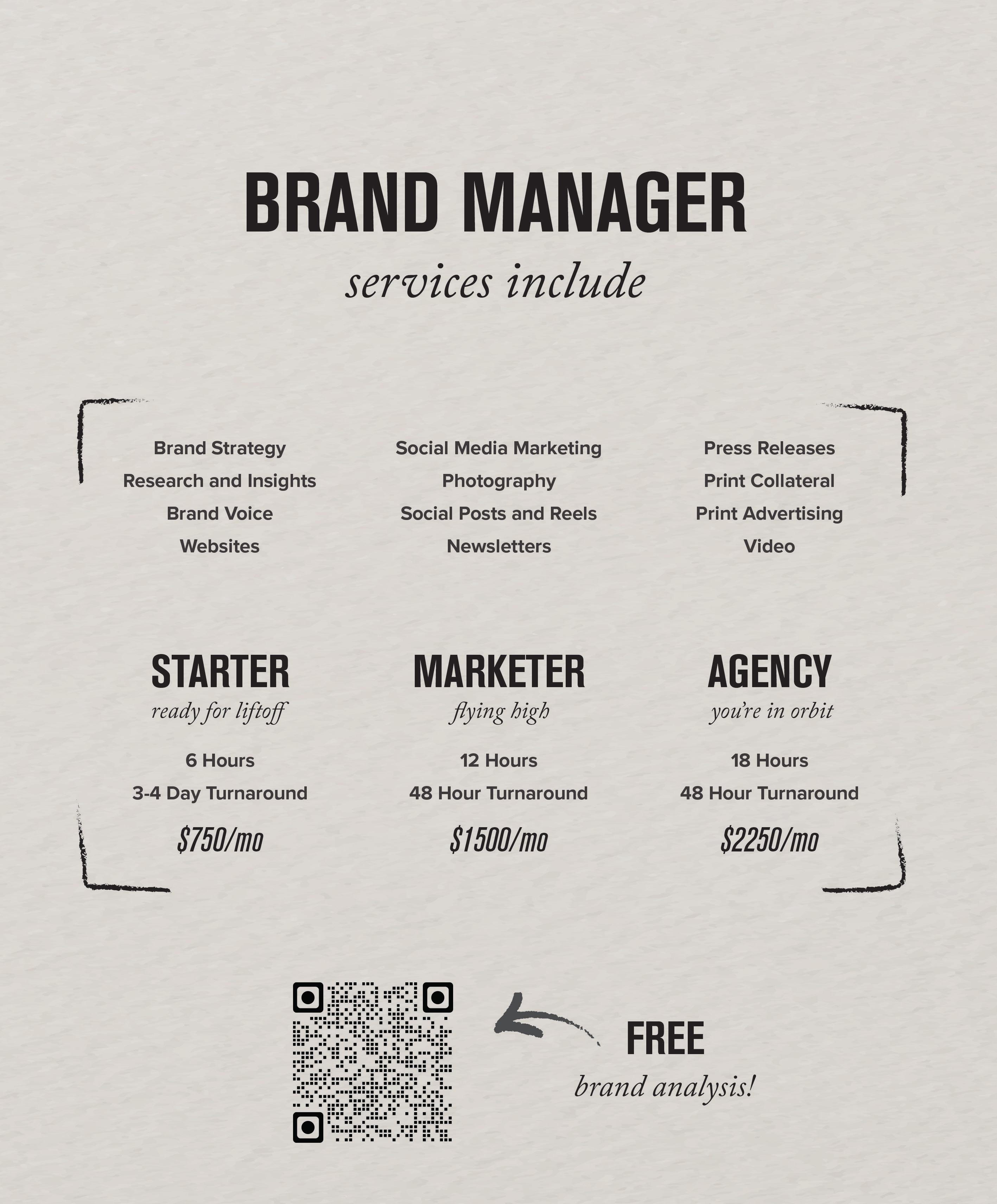
ON THE COVER:
Cultivating Curiosity
There are more than 5,000 Montessori school in the U.S., and the first certified public one was founded in Lakeland. Learn how that movement came together by getting to know Montessori pioneer Josie Hill.
by Jordan Randall
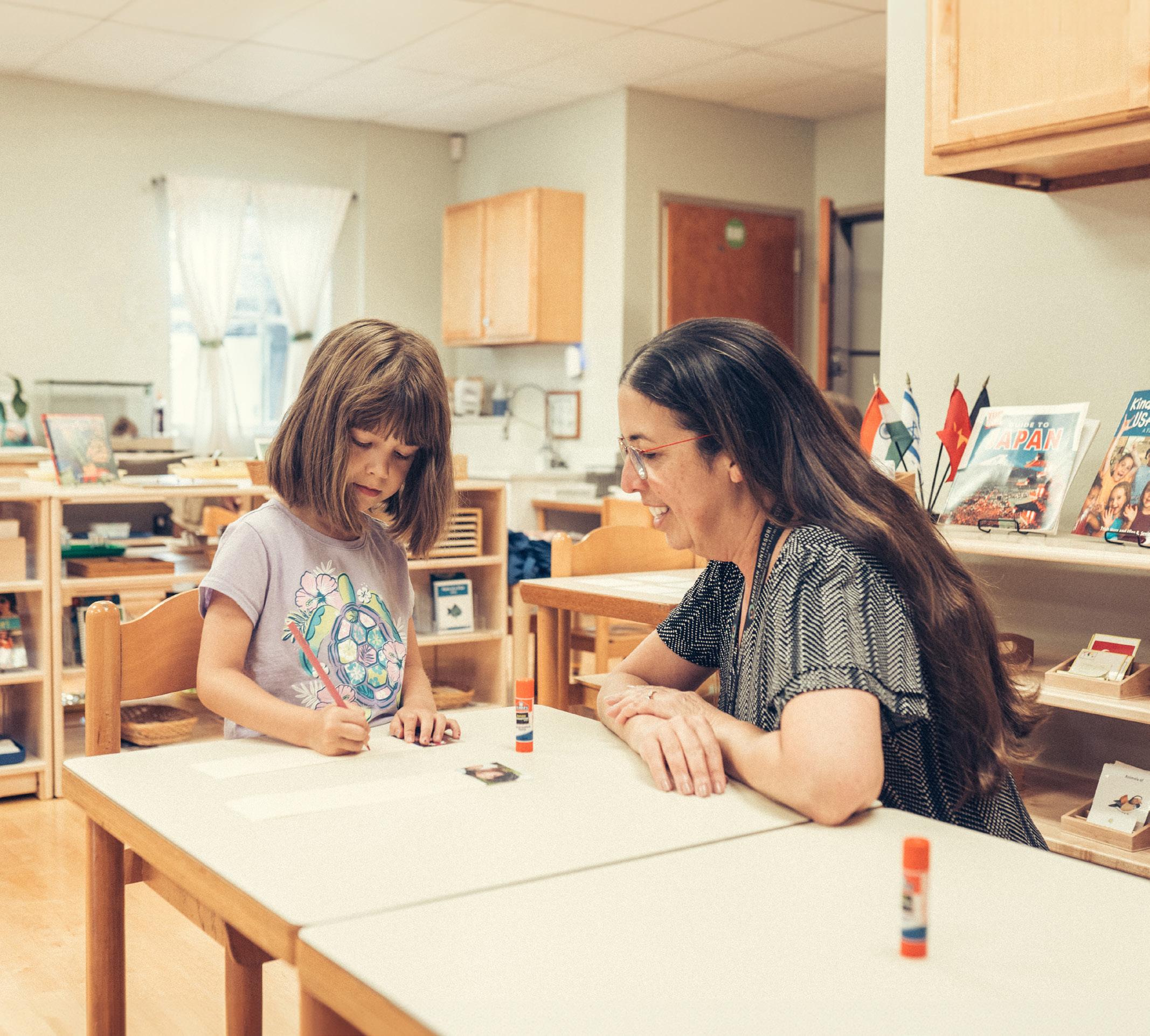




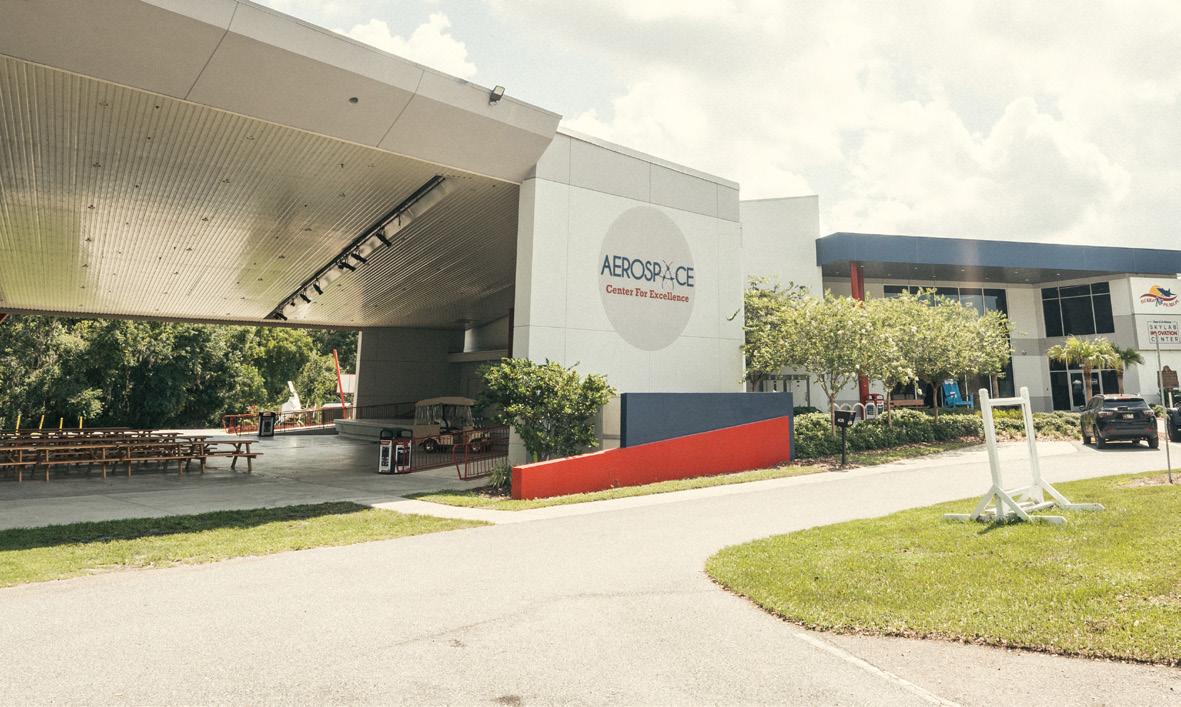

28 THIS IS NOT A GALLERY
What might it look like for a collection of creatives to curate a space that elevates local artists and builds culture?
48 PROUD TO ‘B,’ BUT STRIVING FOR MORE
Superintendent Fred Heid gets honest about the new School Grades, school vouchers and opportunities for growth.
62 BRINGING THE REAL WORLD TO LIFE
A new concept is coming to life at Teneroc High School that puts finance, business and trade work at the forefront of student’s minds.
78 TURNING UP ACES ACROSS THE GLOBE
Students are flying higher in classrooms time zones away from Lakeland thanks to the hard work of local educators.
36 CULTIVATING CURIOSITY
There’s no one-size-fits-all solution to educating young minds, but there are unique methods that provide pathways beyond a traditional classroom.
58 DISTRICT ON THE RISE
See how Polk County Public Schools graded out, and where it has the most room to improve.
66 SUCCESS DOES NOT HAPPEN BY ACCIDENT
A fun, colorful yearbook expression of the 2024-25 school year at Polk County Public Schools.
86 BUILDING ON A RICH TRADITION
The FSC men’s golf team is contending for national titles again, with a familiar face at the helm.
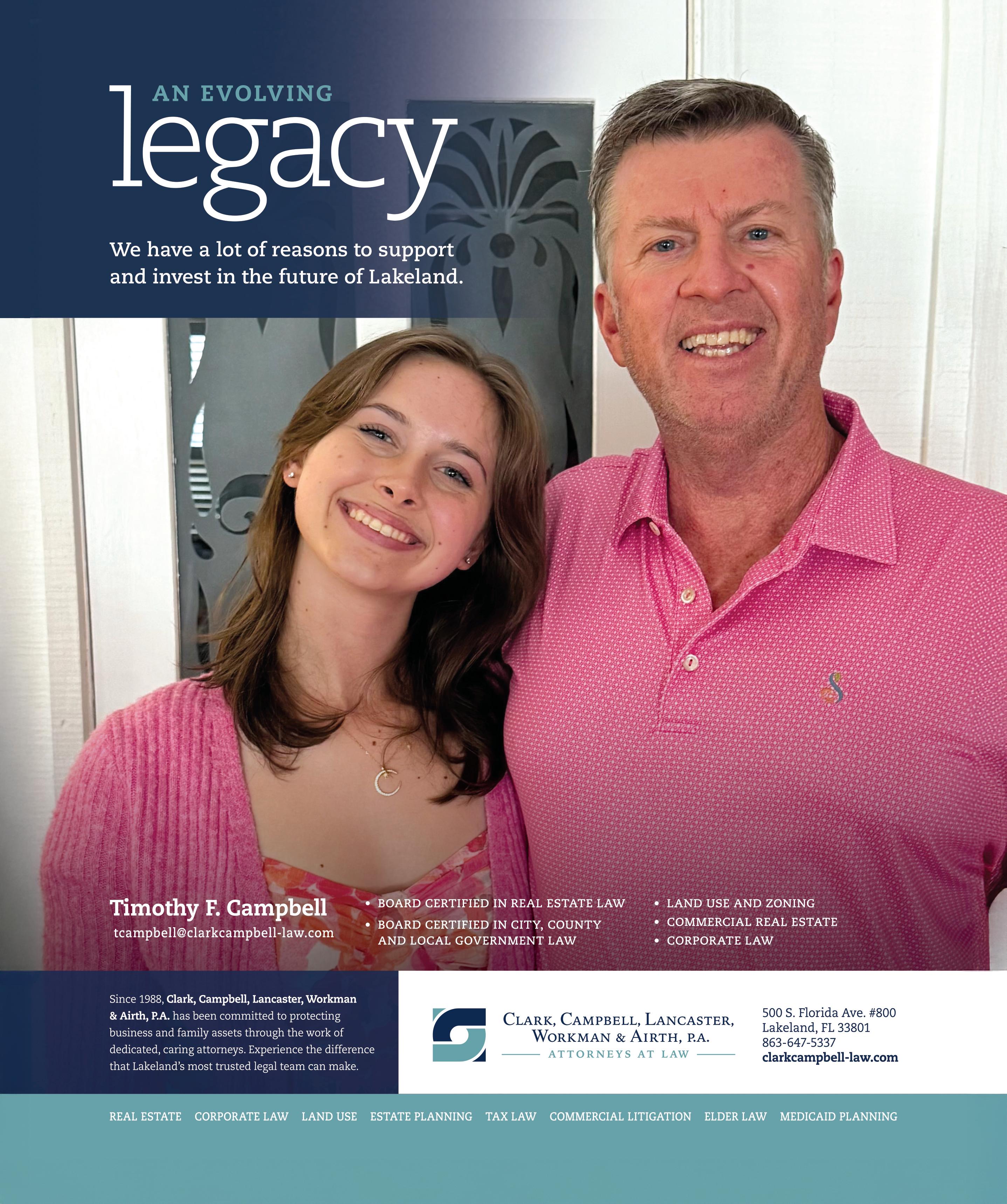

PUBLISHER
Curt Patterson
OPERATIONS DIRECTOR
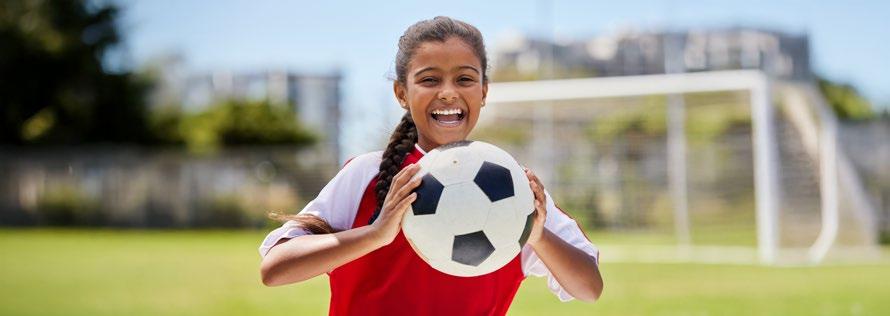
Jason Jacobs VP, FINANCE
Deb Patterson





South Lakeland
BOOKKEEPER
Bechard Bookkeeping
CIRCULATION
CIRCULATION DIRECTOR
Jason Jacobs
DISTRIBUTION
David Heideman
GENERAL COUNSEL
Ted W. Weeks IV
ADVERTISING
ADVERTISING DIRECTOR
Curt Patterson | 863.409.2449
ADVERTISING SALES
Sharon Blackburn | 813.789.4361
LAKELANDER
CREATIVE SERVICES
Jason Jacobs | 803.960.0030
EDITOR, CONTENT STRATEGIST
RJ Walters
GRAPHIC DESIGNER
Allie Brinton
DIGITAL MEDIA PRODUCER
Jordan Randall
GRAPHIC DESIGN INTERN
Elizabeth Perez-Libran
CONTRIBUTORS
EDITORIAL
Victoria Bardega
Holly Cain
PHOTOGRAPHERS
Jack Portune
Lakelander
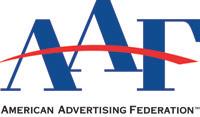




As one of the nation’s leading children’s health systems, Nemours Children’s Health is on a journey to create the healthiest generations of children. That’s why Lakeland Regional Health and the experts from Nemours Children’s have teamed up to provide pediatric services right here in your community.

When anyone makes passionate blanket statements about education in Polk County I often think to myself, “It seems like they have had a child in every type of school around, and they must have familiarity with everything from ESE professionals and Montessori education to public charters and how and why the school zone boundaries are drawn the way there are.” Then I find out they have one child just beginning first grade.
It’s healthy to have an emotional attachment (it means you care) to the institutes of learning that we depend on to help develop and train our loved ones, but I am not OK with placing sole responsibility for the outcomes of local students on principals, administrators and staff members, and neither should you be.
I am tired of people lamenting the state of education in our communities while simultaneously celebrating so many of the incredible leaders, entrepreneurs and community servants who live here, who in fact (the data proves out) went to the exact schools I hear people whining about.
School Grades as determined by the state matter—and we are rightfully applauding PCPS being back to “B” status this year—and good and bad experiences are profoundly important—I just want you and I to try and take a long view on the state and future of education in Polk County so we become more engrossed in the process and less critical every time we feel like someone or something has failed.
If you want to go back to elementary school with me for a moment, I propose a better equation looks more like this:
Staff preparation and performance (×) parent and community support (+) student responsibility (+) innovation based on research and proven needs (+) adequate funding and resources (−) expecting every student to learn in a similar fashion = a system built on partnerships that we can expect much from, but offers mutual grace in times of struggle.
I think in many places in most schools in our county that kind of formula is taking

root, and professionals, caregivers, parents and educators are making strides together, even when additional resources to support those strides are not guaranteed.
It is a privilege to be married to a fabulous lifelong educator (shout out to Mrs. Walters at HGE), to personally know hundreds of teachers and to tour schools and interview education leaders on a regular basis. Based on my perspective, here’s what I’m looking for from our educators:
• Timely, transparent communication
• Collaboration that identifies gaps and weaknesses across the board and works toward solutions for all types of schools
• An “I’m sorry” when someone at a school or district falls short (which happens, and is an important part of shared growth)
• New ways to engage new technologies and recent research
• The same grace for me, and my children (who are wonderful, but we still get calls about from time to time) as we should give them
I don’t plan on running for the school board anytime soon, especially if the goal is to hear less gnashing of teeth, and yes, I have a soft spot for developing youth into productive adults. When you’re deciding if local education is “making the grade” make sure to insert yourself into the whole story, not just the chapters you keep bookmarked.

RJ Walters EDITOR


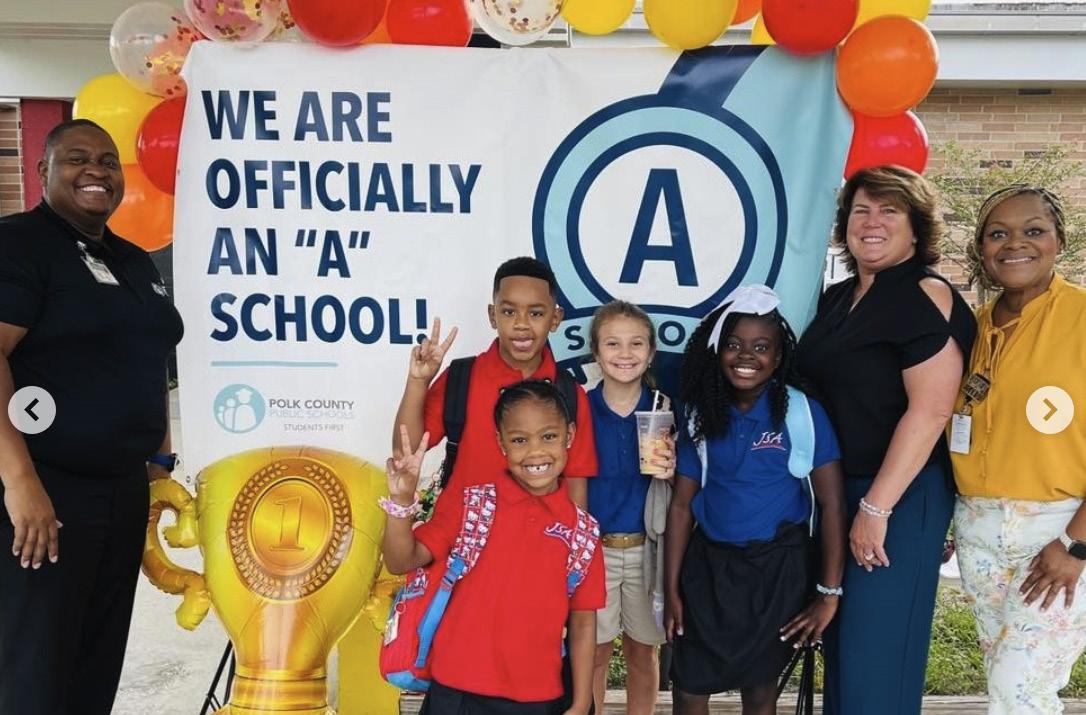
polkcountypublicschools Aug 1
Scenes from the first day of school in Polk County. So good to see you again! #lovePolkschools #polk #polkcounty #polkcountyschools #polkschools #polkcountypublicschools #polkcountyfl #polkcountyflorida #backtoschool


Aug 6
We had a blast welcoming nearly 1,000 freshmen to our campuses as they prepare for the 2025-2026 Academic Year!
Fall classes start in ONE WEEK on August 11!
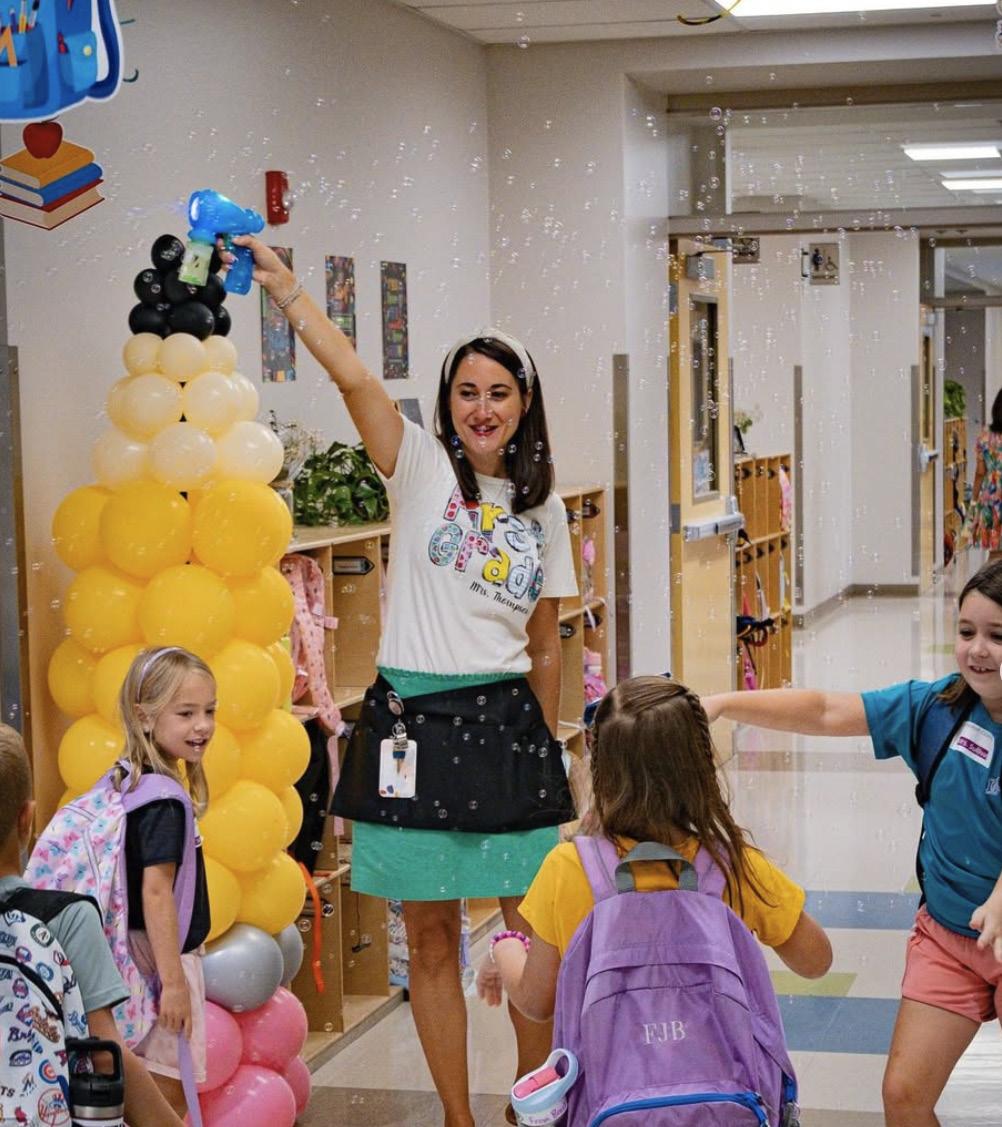
lcsvikings Aug 13
What a joy to see our campus buzzing with excitement again!
The 2025–26 school year has officially begun, and our halls are filled with smiling faces and students ready to learn and grow.



Jack Portune is a Florida-based photographer originally from Cincinnati, Ohio. With more than five years of experience behind the lens, he’s captured everything from collegiate athletics at the national level to large-scale events.
Most recently, Jack photographed the Miss Florida Pageant and has also worked with organizations like Goodwill. His experience includes everything from graduations and senior portraits to banquets and corporate events. Whether behind the camera or designing visuals, Jack brings intention, creativity, and a passion for storytelling to every project.
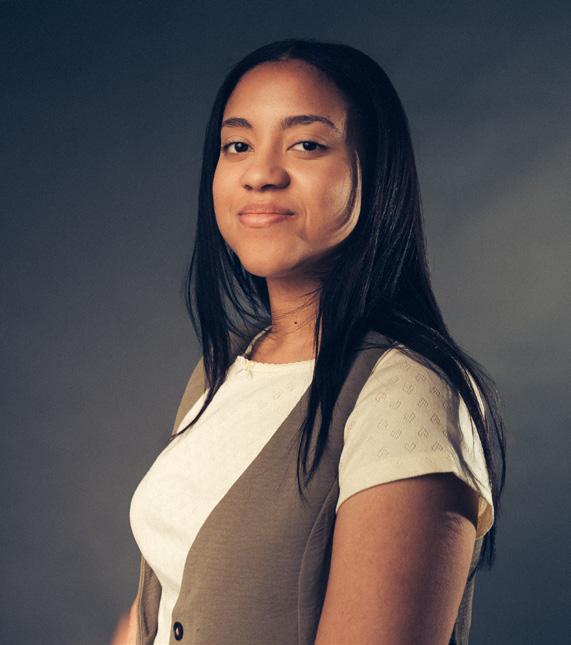




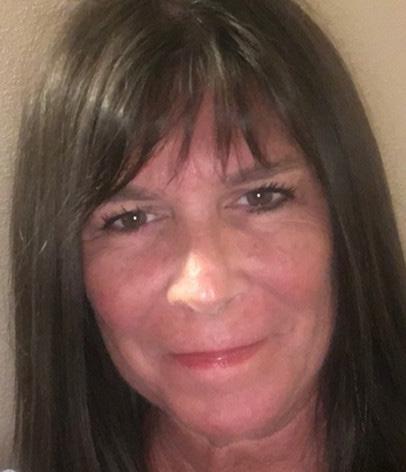
Elizabeth was born in Miami but raised in Winter Haven, Fla.. She is currently attending Florida Southern College, where she is pursuing a bachelor’s degree in Graphic Design. She hopes to find a job in the future that fills that need and passion to design and use her talents, while also learning and growing.
When she’s not designing for The Lakelander or school you can find her viewing installations of paintings and sculptures that inspire her at The AGB Museum of Art and enjoying local restaurants, libraries and the natural beauty of Lakeland’s parks as she integrates herself more into everything Lakeland has to offer.
Holly is a proud Lakeland High School alum and graduate of University of South Florida who has established herself as a premiere sports journalist, and one of the finest NASCAR writers in the history of the sport. She was the first woman to receive the Bob Russo Founders Award, an honor given for “dedication to motorsports” while showing “courage and providing inspiration in the face of personal adversity.”
She has worked at large daily news outlets including The Tampa Tribune, Dallas Morning News and Seattle PostIntelligencer. She is a published author of several books including “NASCAR Mavericks: The Rebels and Racers who Revolutionized Stock Car Racing.” She loves the beach, being a mom and David Bowie.
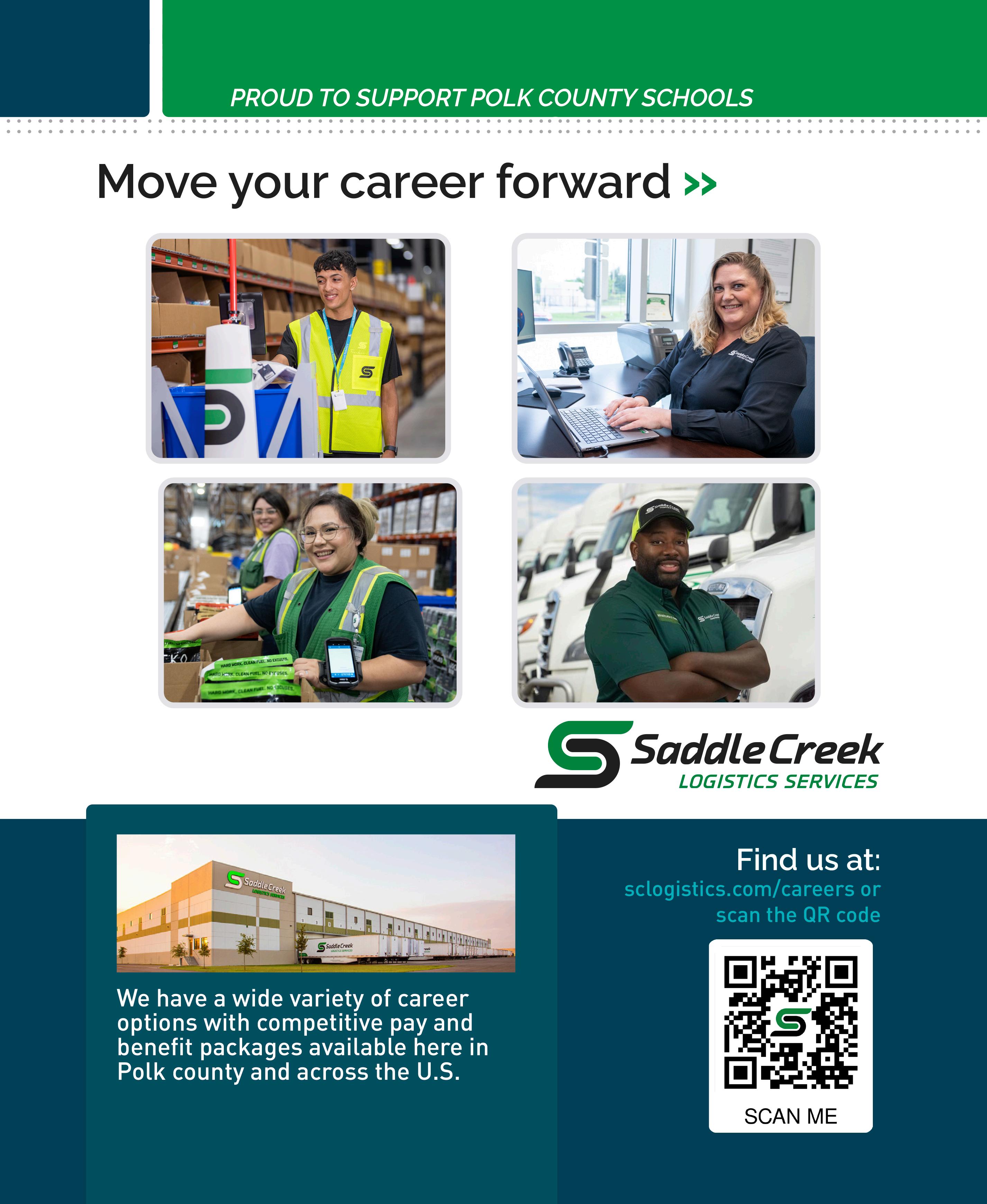

WRITTEN BY LYDIA GUZMAN
PHOTOS PROVIDED BY FLORIDA POLYTECHNIC
Performing maintenance outside the International Space Station is a complex and risky task that requires astronauts to wear bulky space suits and conduct spacewalks to repair vital components like the station’s protective multi-layer insulation. To improve safety and efficiency, NASA continually seeks innovative solutions to support this critical work.
Now, a team of mechanical engineering students from Florida Polytechnic University has stepped up with a promising new idea. The group of rising seniors designed a tool aimed at simplifying a common challenge faced by astronauts: securing two overlapping pieces of a specialized fabric-like material when only one side is accessible—mirroring real-world conditions outside the ISS.
“If there was something wrong with the fabric and it needed to be repaired, our device would essentially put a new piece of fabric on top,” said David Chazbani, a student from Parkland, Fla. “Our NASA mentors gave us a lot of good feedback throughout the project about things like piercing the fabric and how comfortable the tool will be for an astronaut to use with their gloves.”
The creative device has the potential to improve the way astronauts conduct repairs, reducing risks and increasing effectiveness during spacewalks on the 25-year-old orbiting laboratory.
The effort was part of NASA’s highly selective Micro-g NExT Challenge, which tested collegiate teams’ designs at the agency’s Johnson Space Center in Houston, Texas, in early June. This was Florida Poly’s first time participating
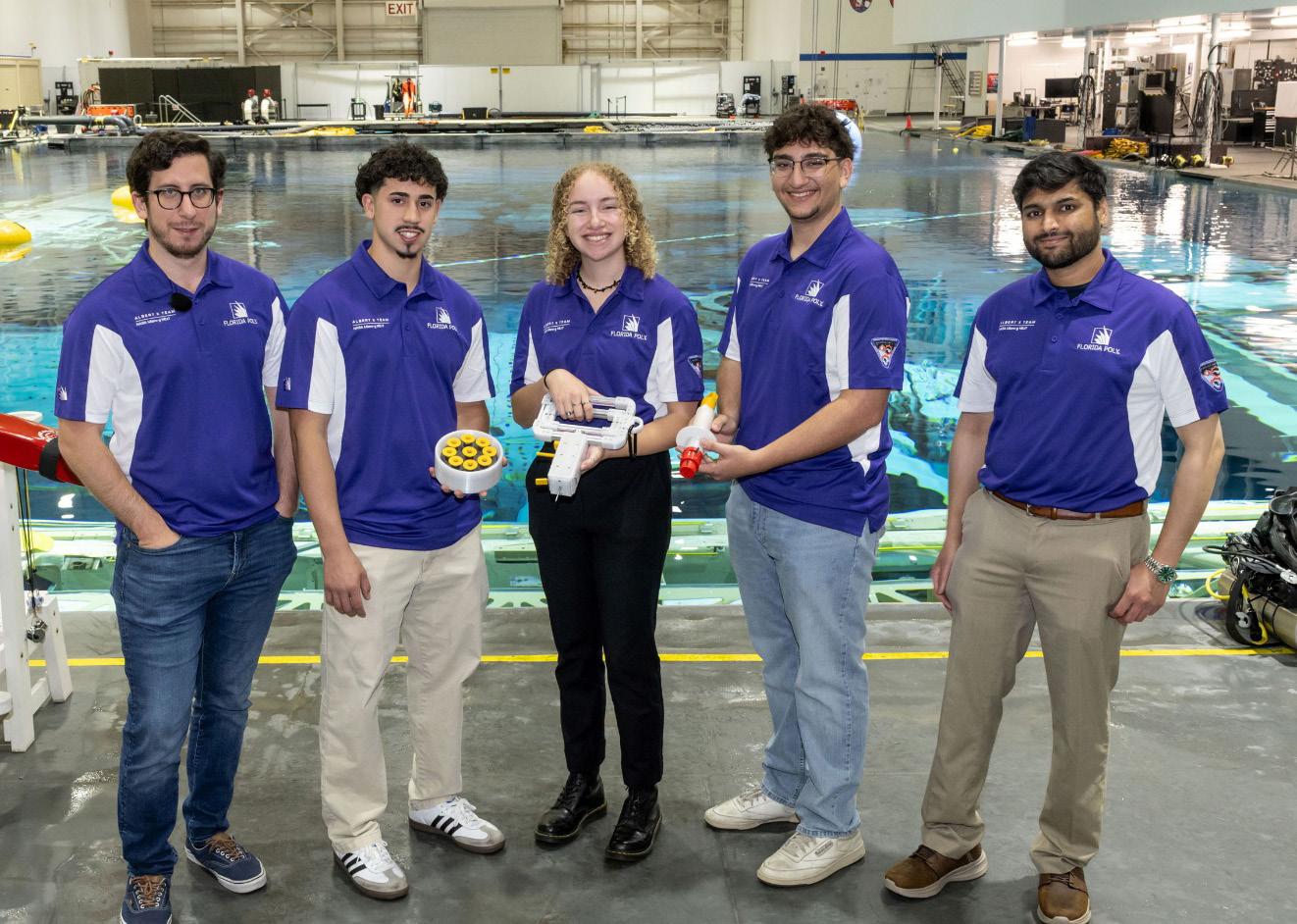
in the event, joining only 16 other schools from across the country, including Virginia Tech and Embry-Riddle Aeronautical University.
NASA divers tested the team’s device underwater at the agency’s Neutral Buoyancy Lab to simulate conditions in space—and the results were nothing short of perfection. Florida Poly’s device was the only tool to successfully complete the challenge.
“The testers said that our device was the closest thing they’ve seen to something they would actually create and design for themselves to use, and that was the greatest compliment we could receive,” said Eduardo Jirau, the team’s lead.

Following a flurry of success in 2024, including hitting #1 on Apple Music’s Christian Music Chart, SEU Worship dropped its latest album “A Forgiving God” earlier this summer.
A press release from Southeastern University says the album “is a reflection of the journey Southeastern University’s campus has taken through seasons of prayer, creativity, and rediscovery of God’s mercy.”
The songs explore the honest experience of continually striving to draw near to God, falling short and seeking His mercy that can lead to healing and redemption.
“A Forgiving God” is a nine-track album that departs from the structure of traditional worship formats. Instead, it leans into creative expression and intentional storytelling, using a blend of folksy instrumentation and indie textures, which are designed to capture the evolving sound of SEU Worship. Influenced by extended worship moments, prayer chapels, and the broader movement happening on campus, the album reflects a dynamic and evolving expression of praise.
Two songs from the album that are currently available, entitled “Fruit Takes Time” and “Dwell,” offer a soundtrack for real-life faith. In the first two months after being released these two singles surpassed 2 million streams collectively. You can listen to the full album anywhere you listen to streaming music.
Polk State College’s Occupational Therapy Assistant (OTA) Program recently launched a partnership with The Mission of Winter Haven to provide students with meaningful, real-world experience while empowering individuals facing homelessness and hunger through targeted life skills training.
The first of its kind in the nation, this hands-on collaboration allows Polk State’s OTA students to assess clients at The Mission, design interventions and deliver group programs under the supervision of their clinical coordinator.
“We wanted to reach out to occupational therapists and occupational therapist assistants because when people ask what the greatest thing people need is, it’s a support system,” said David Berry, the Executive Director of The Mission. “That’s what OT helps us create for our people—a support system to flourish, to grow and to be everything they were created to be.”
The result? A powerful blend of education and service that is already changing lives.
The program has assisted several individuals, including:
- Four individuals or families with securing housing
- Two veterans who are now receiving full-service support, including housing and Veterans Affairs services
- 14 individuals who have gained full-time or part-time employment
- Six previously homeless clients who have transitioned into parttime paid roles at The Mission, thanks to their successful participation in training and competency development facilitated by OTA students
The success so far has led to The Mission formally embedding occupational therapy into its intake process and service delivery model, Gonzalez explained, with OT recognized as a core component of the organization’s ongoing resources.
“In a significant step toward program sustainability, The Mission has committed to hiring a full-time Certified Occupational Therapy Assistant (COTA) from the Polk State College graduate pool to further implement and expand this initiative,” she said. “This model sets a national precedent for integrating OT services into community-based settings that serve underserved populations.”
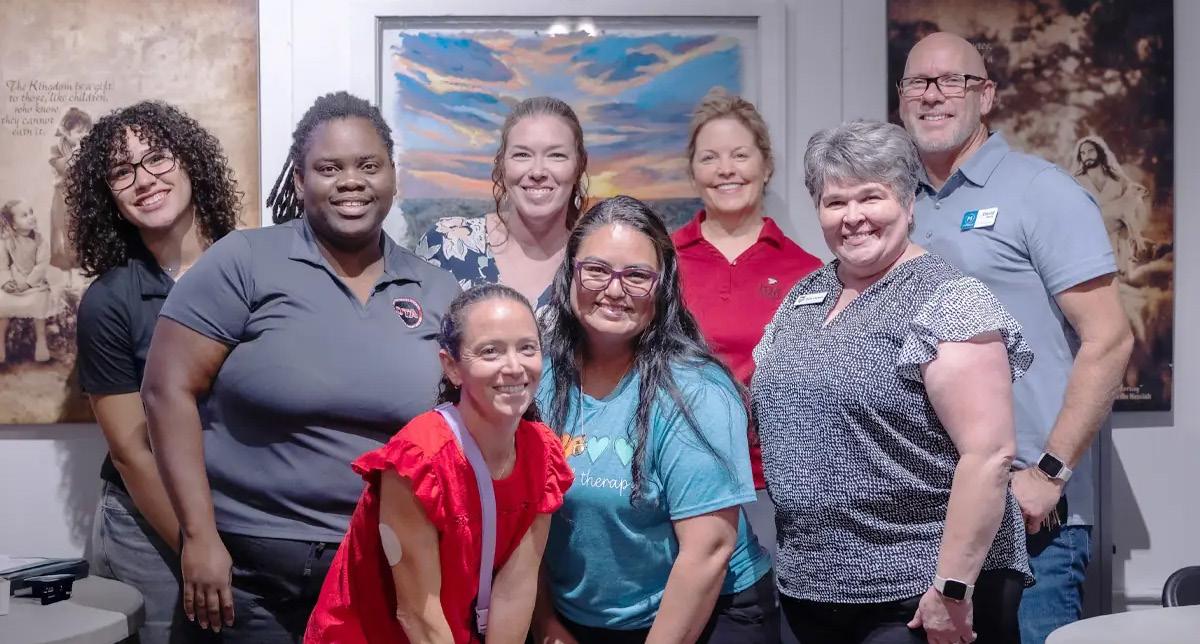
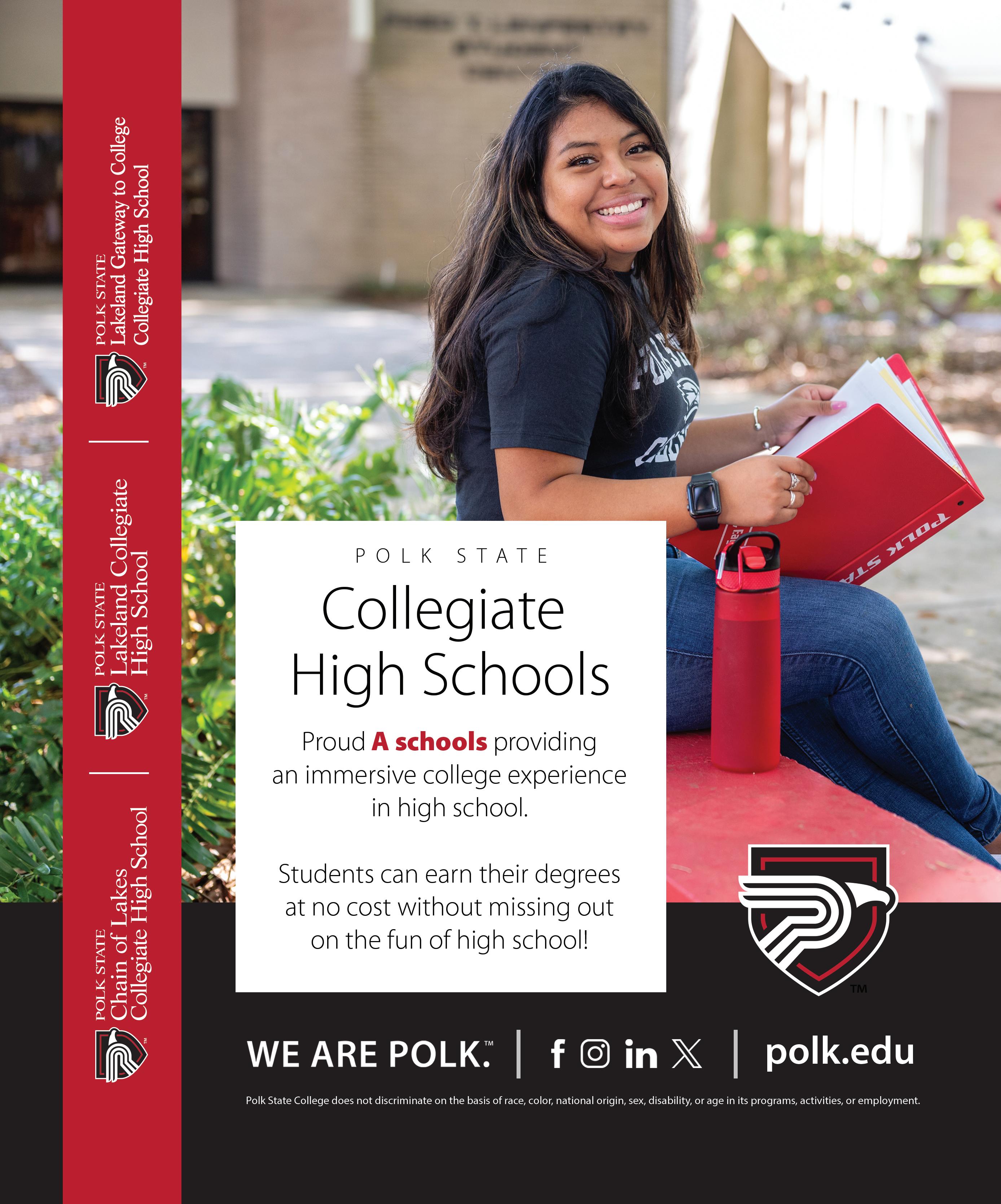

hen the summer heat spikes, so do electric bills, and for many households, that means tough decisions and looming shut-off notices. Losing service isn’t just an inconvenience—it can be costly, leading to late fees, reconnection charges and the added stress of getting reconnected during the hottest months of the year.
This year, Lakeland Electric is taking a different approach. Through a partnership with technology provider Promise, the utility has already helped more than 8,500 households access $8.2 million in federal aid from the Low-Income Home Energy Assistance Program (LIHEAP)— without waiting for customers to ask for help.
“We’re not waiting for people to call us in crisis,” says Korey Bush, Assistant General Manager of Customer Service. “We’re reaching out early to offer help, including to those who’ve never applied for assistance before.”
The partnership came together quickly. In April, a Lakeland Electric finance executive attended a municipal roundtable where Promise presented its model. Recognizing its potential, the team moved fast to finalize contracts and processes in time to meet the next LIHEAP disbursement deadline just a week later.
LIHEAP, a federally funded program administered at the state level, isn’t new to Lakeland Electric. Traditionally, though, it’s been customer-driven— requiring individuals to seek out and apply for help. With Promise, the process flips.
Here’s how it works: Lakeland Electric securely shares customer data with Promise, which cross-references it with LIHEAP eligibility criteria. Promise then proactively notifies qualifying households through texts, emails, and other direct communication that assistance is available. Customers can choose to decline, but if they accept, approved funds are applied directly as a credit to their electric bill.
Funding is available for households that have an income of 60 percent or less of the Florida State Median Income or 150 percent of the Federal Poverty Level or receive SNAP, TANF or SSI benefits.
The program covers two types of aid: an annual home energy allotment and a crisis fund, which can go toward a single bill or past-due balance, with combined benefits of up to $2,000 per year.
“The impact has been huge,” Bush says. “In May and June alone, over $8

million was awarded to our customers, with more than 4,900 awards issued in June. We’ve already seen a significant drop in disconnections compared to previous years.”
The proactive outreach has prompted mixed initial reactions: some relief, some skepticism. “A lot of customers thought it was a scam at first,” Bush admits. “But once they realized it was legitimate, the gratitude was overwhelming. They told us they weren’t sure how they’d make it through the summer otherwise.”
While Promise’s notifications are the primary outreach tool, customers can also call Lakeland Electric’s customer service team to confirm eligibility or ask questions. The utility has published blog posts and informational resources to reassure residents and explain the process step-by-step.
The funding renews annually on Oct. 1. Lakeland Electric expects the program to continue as long as federal dollars remain allocated, and the

early success has sparked internal conversations about how to bring a similar proactive approach to other services.
For Bush, the initiative is about more than numbers. It’s about neighbors. “We’re a customer-owned utility. I’ve lived here for 22 years. We shop at the same stores, go to the same churches, send our kids to the same schools. We want to do more than deliver power—we want to make life a little easier for the single mom or for the family that’s stretched thin.”
While no program can control rising energy costs or inflation, Lakeland Electric hopes that removing barriers to assistance will help stabilize household budgets and prevent the financial spiral that comes with losing service.
One more LIHEAP allocation is scheduled in the coming weeks, and Bush expects demand will remain high through the peak summer months. “We can’t stop the heat,” he says, “but we can make sure our community has one less thing to worry about.”









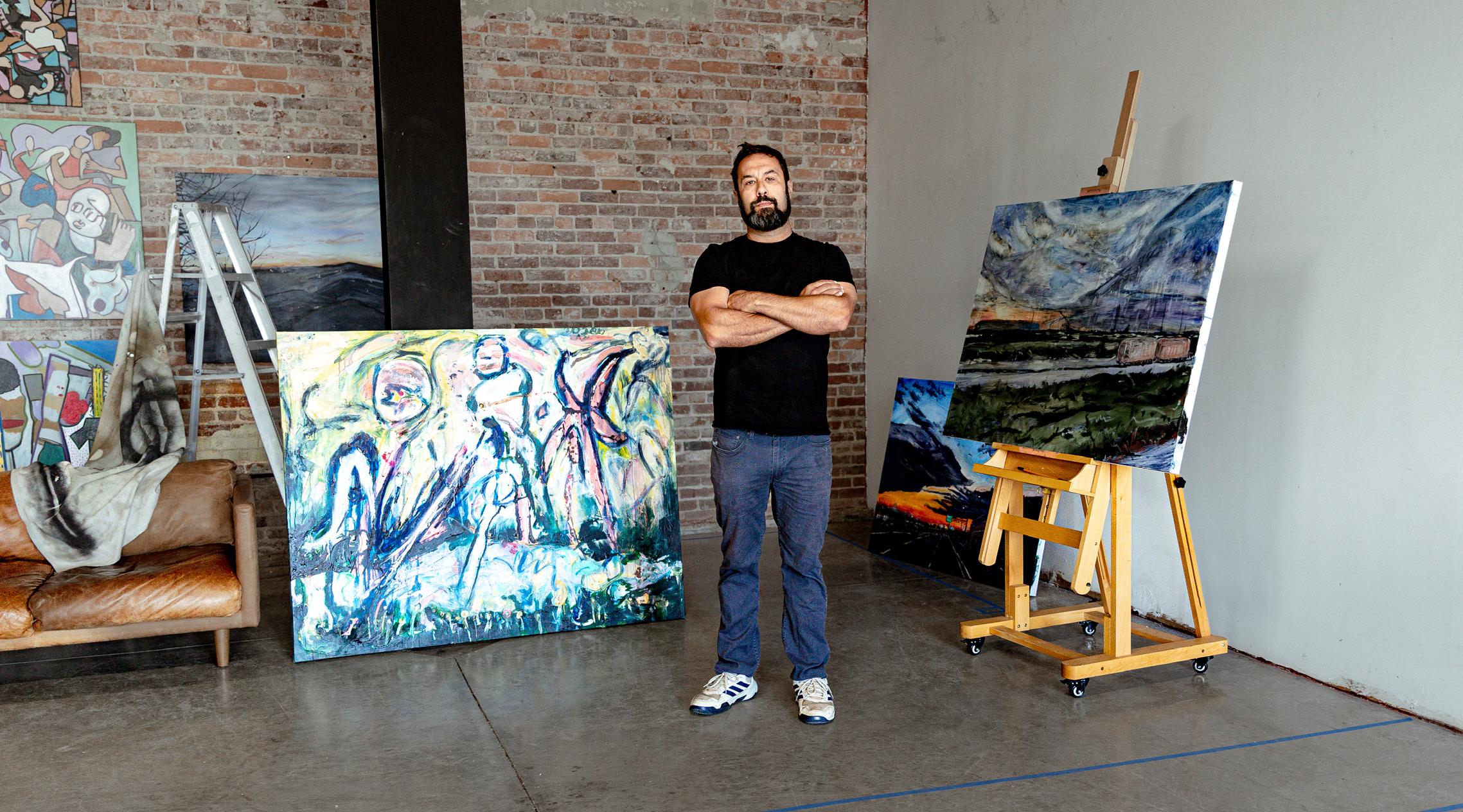
see Lakeland on the precipice of becoming more of a cultural hub,” says Andy Webb, the co-owner of Kynd Design Co., standing inside the rapidly evolving space at 125 N. Kentucky Ave., Suite 103. “From the addition of The AGB, current redesign of Munn Park, the Sears Town Art development and the investment in Bonnet Springs Park, Lakeland is quickly becoming very cool. With more galleries, restaurants, and creatives, Lakeland will become an even more attractive destination and that’s where we fit in.”
When he says “we” he’s referring to his wife, Katie—a co-owner of Kynd—as well as Tony Agnello and his fiance, Danielle Klonecki, the four partners who are turning a dream into a concrete
reality with Notta Gallery, a one-of-a-kind space where the goal is to elevate local artists and foster a space where people of all ages can create, learn and commune.
Tony is skilled at many things, but sitting still is not one of them.
When he and his business partners came together for a magazine photo shoot he couldn’t resist pulling out his phone, tossing out ideas at a rapid pace. True to form, Tony steered the photo shoot from inside the gallery space straight into the middle of Kentucky Avenue in downtown Lakeland. Why not pretend to be Ringo Starr on Abbey Road 56 years after the iconic photo was shot? If no one else is going to take the leap, Tony will.

Left to right: Danielle Klonecki, Tony Agnello, Andy Webb and Katie Webb reenact the Beatles’ famous Abbey Road album cover just outside their new space, Notta Gallery.
Many Lakelanders know Tony as the owner of Lakeland Air Conditioning, the company famous for its avant-garde advertising, but few know one of his burning passions is much less technical and by the book.
It was during a paddle boarding trip down the Weeki Wachee River last year that something clicked—a fuse long dormant finally reigniting.
He and Danielle both started sketching and painting at a feverish pace, tapping into creative energy that had been buried for years. Tony, a fine arts graduate of Pratt Institute in New York City, had let his artistic side rest for over 20 years. Like many artists, paying bills and raising a family took priority. But the flame had never fully extinguished.
At 43, Tony describes himself as “open and fearless” when it comes to bringing chaos into order on a blank canvas. Now, he and his partners are ready to share not only their perspective but a new creative space with the Lakeland community.
In the space previously occupied by June Taylor, Notta Gallery is set to come to life in early September. The gallery’s cheeky name was chosen with intention Notta Gallery will showcase local artists in its 2,000-squarefoot space, but it will be more than just a gallery.
The space will feature art classes, workshops, and a robust retail side, offering affordable and unique art pieces. The team envisions a dynamic, ever-evolving space that is welcoming and engaging.
One of the artists who will be featured
|

at Notta is Chris Roll, a renowned local artist who teaches painting, drawing and 2D design at Lakeland High School.
He painted out of ART/ifact Studios for seven years and specializes in figurative oil paintings exploring concepts of nostalgia, interpersonal relationships, solitude and vulnerability.
“Notta Gallery provides a platform for local talent to gain exposure and experience without needing to relocate,” says Roll. “People want to connect with the story behind the art. My work, for example, tells stories of family and experience.”
As Katie puts it, Notta “wants to build something that matters and wants to be part of the community.”
“We’re starting this venture just as the Lakeland Arts Association is opening 35 new artist spaces,” Andy adds. “We’ve been in some great collaborative discussions, and we’re excited to be a part of this cultural shift.”
“We’re going to try to de-program our people from Hobby Lobby,” Agnello says. “You can go there and buy the same thing that a hundred thousand other people bought or you can come here and buy something that no one else has, which [includes] a connection with someone that created it.”
Tony loves figuring out what puzzle pieces it takes to bring something together, and in this case, he’s excited about how each partner brings distinctive skills to the table.
Danielle draws on more than 20 years of business acumen she has gained working as an integral part of a national award-winning automotive group. She said this project is reawakening her creativity in a whole new way, and that sensation is only heightened by the number of artists who cannot wait for Notta to open.

Katie and Andy both grew up in Lakeland, but their creative paths led them to the Savannah College of Art and Design, where they honed their skills in architecture, fine art and textile design. After years away, they returned home in 2020 with a shared dream to blend their talents into a business that would help other businesses shine. That dream became Kynd Design Co., their husband-and-wife venture specializing in interiors and branding with soul. Known for their deep-dive approach, they uncover each client’s story and translate it into thoughtful spaces and visuals that feel as good as they look. In just a few years, they have worked to help transform local storefronts, boutique hotels, and brands into experiences that customers connect with and remember.
For Danielle, the most rewarding part of the journey has been the overwhelming support from the local art community.
“You can’t help but feel inspired by the encouragement we’ve received,” she says. “Everyone has been a dream to work with, and that positivity keeps us moving forward.”
The possibilities for Notta Gallery seem endless. The team is already discussing supper clubs, live art events, private rentals, and collaborations with local staples like Art Crawl, Health in Medicine and First Friday events.

Top: “Study for Mourning Light,” produced by Lakeland artist Chris Roll, is an example of the kind of work people can expect to be featured and sold at Notta Gallery.


Bottom: “Stones Beneath the Current” by Tony Agnello, spray paint and oil paint, 60”x48” Prospective Gallery Partners Can Email Portfolios to nottagallery@gmail.com 125 N. Kentucky Ave., Suite 103
The vision for Notta Gallery is just one part of a broader dream to help Lakeland become a destination—and Tony believes that by “taking this swing, perhaps others will follow.” To better understand the vision for Notta someone will have to visit the space, and having a conversation with Tony will bring it all into living color.
Waxing poetically about how he describes Notta, he says the following:
“Notta” is that friend you meet in the middle of a crowded room who somehow makes the whole place feel like yours. She’s dressed in color you can’t quite name, laughing at the edge of the conversation, pulling you toward something you didn’t know you needed to see. She’s part old-soul, part troublemaker, never showing the same face twice—one day she’s a quiet poet in the corner, the next she’s up on the table starting a revolution. She can dress down and sit cross-legged on the floor painting with kids, then slip into a little black dress and host a bourbon tasting without missing a beat. She’s the heartbeat of Lakeland’s creative pulse, a place and a person all at once—where art doesn’t just hang on walls, it spills into your hands, your eyes, your story. Everyone swears they know her, but the truth is, she’s always becoming.
Sept. 5, 4 to 10 p.m. and Sept. 6, 8 a.m. to 2 p.m.








WRITTEN BY HOLLY CAIN
BY JORDAN RANDALL


osie Hill’s eyes light up and her smile widens telling the story of a lifelong love of school and education, something she has appreciated, cultivated and ultimately now shared with hundreds of Polk County families since founding Lakeland Montessori School in 2004.
“I really liked to learn about everything,’’ Hill, 53, recalled of her days growing up in a small town on the Illinois-Wisconsin border. “School was really my happy place. It created who I am. I loved my teachers. I loved everything about it.
“You know how they say, ‘I walked two miles in the snow uphill,’’ Hill said of the epic—often-exaggerated—phrase told to young students.
“There were days when I would wake up in a blizzard and I would actually walk the two miles to school in the snow. And school would be closed and I would be like, ‘oh no, I want to go to school.’”
The story says a lot about Hill, truly one of Polk County’s educational pioneers. Years later, after moving with her young family to Lakeland, Hill took that proverbial tough walk again— this time in sunshine—to help spread the Montessori educational concept, ultimately establishing a public Montessori School where Polk County students have now thrived for more than two decades.
“After our family moved to Florida, there was this side of me searching and asking, how can I contribute? What will my life’s work be?” Hill said. “I heard about charter schools and I had heard of Montessori and it just kind of clicked. This is it. I want to start a school and I want it to be Montessori and I want it to be public. She did extensive research, including in-person visits to a variety

of charter and Montessori schools throughout Florida, and a strong majority consensus from school leaders was “you’ll never be able to have an authentic Montessori program in a public school setting.”
“I’m the kind of person where just because you say ‘no’ to me, I say ‘let’s see, let’s explore more,’ … and I said, ‘I’m going to do it.’”
And she did. That’s not to say it was an easy process, however. It took a lot of work, from Hill and the increasingly large pool of parents and community members who supported the idea of bringing Montessori’s non-traditional education methods to Lakeland.
Lakeland resident Nancy Moses recalled seeing a flyer about a meeting Hill organized at the Lakeland Public Library in the early 2000s. About 40 local families showed up to listen to Hill explain the concept of Montessori that evening and many— enough—left convinced they wanted to help bring it to fruition.
“Obviously, she made it happen and without her, none of this would be,’’ said Moses, whose daughter Emma and son John attended Lakeland Montessori from pre-school through eighth grade. Emma—who was part of the inaugural 3-year old class at the school—is now a law student at George Washington University in Washington D.C. and John is a physics major at the University of Central Florida.
“I think at the beginning it was incredible that Josie decided she wanted this for her own girls and so she just took a leap [of faith] and made it happen and then obviously invited all the rest of us around for the ride,’’ Moses continued. “The fact she did it as a public charter school I think is such a big part of the story.
More typically, Montessori is expensive and not available to everyone so that was a big deal that it was truly for everyone.”
That core Montessori curriculum is based on the concept of “Five Great Lessons” which are integrated into all studies in age-appropriate ways that not only create the foundation for academic success but for broader life lessons. They range from the “Coming of the Universe” to the “History of Language” and “History of Numbers” and the proof of concept comes from self-led learning, not traditional report cards.
For the very youngest students, math, for example, is understanding addition through blocks, lots of hands-on and sensorial opportunities. As they get older, students take turns being the class “zoologist” to care for the various classroom pets. The older students have electronic tablets for use and eventually each middle schooler has access to a laptop, but the electronics stay at school.
Not only did Moses support Hill’s work with Montessori, she joined in the foundation, helping write a separate charter for the middle school (grades six through eight). And today the Lakeland Montessori School, which Hill founded in 2003, serves students from 3years old through eighth grade.
Beyond that, Hill, who now serves as the school’s (CFO) Chief Financial Officer, got the Lakeland

Montessori approved through the Polk County School Board as a charter school – meaning there is no tuition (from kindergarten through eighth-grade). In fact, Lakeland Montessori was the first American Montessori Society-school in the state to receive that “charter school” designation. It was also the first AMS school in the country to be designated public.
And her work and passion are recognized not just locally—where three additional public Montessori schools are now established in Polk County—but also at a state and national level.
“Incredible determination and focus to reach a goal and commitment to do it and do it well,’’ Kitty Bravo emphatically says of Hill.
And that’s a big accolade coming from Bravo, who has been involved in Montessori education for nearly 50 years and is currently the Director of Education for the Center for Guided Montessori Studies, a global Montessori teacher education and certification program.
“Not only is it [Lakeland Montessori] a success because it’s a solid, wellrespected school that is full [of students], but it’s the quality of it. It is exceptional and I’m proud to have been able to help her create that but that is due to her work and the work of those that have worked with her through the years.”
A visit to the Lakeland Montessori School, tucked away a couple blocks off the shores of Lake Parker, provides vivid testimony – and appreciation - of the concept. Former Polk County Public Schools teacher Chelsea Waldron is the current principal and her pride in the facility and purpose is unmistakable.
“We truly believe that our hope for peace can be found in the smallest of those we educate,’’ Waldron said. “Josie has made a significant impact not just on the students at Lakeland Montessori, but around the world with the partnerships she has created with other Montessori educators.’’




The school—after working out of various sites around Lakeland— now sits on two acres. Inside the classroom buildings there are no florescent lights, but lots of wood furniture and natural colors on the walls. All purposefully done. Classroom size is limited and Lakeland Montessori, which currently enrolls 200 students, has a waiting list of nearly 2,000.
Inside one of the main hallways, a banner with a passage from the childhood favorite, “A Velveteen Rabbit” hangs on the wall. A tortoise and hermit crabs have classroom homes to help with science. A butterfly garden thrives outside the buildings near outdoor class tables with playground equipment on the lawn in the near distance.
The youngest students don’t wear shoes with shoestrings until they can tie them themselves— a subtle lesson in independence. No backpacks are necessary in this primarily “homework-free” setting and while lunch-from-home is the norm, the classrooms feature full kitchens that are available for students to prepare meals— as cooking is part of the all-around program as well.
In each classroom you will find a “peace table”, a designated space for students to calm down and work through disagreements independently.
There are field trips, guest speakers, even a student-led “business” selling things like coffee to parents to raise money for the trips, which are decided upon by the students with a discussion and vote—a civics lesson of sorts. The concept of community is unmistakable here.
The graduates of Montessori education are plentiful and impactful in so many forms of work. National Basketball Association (NBA) superstar Steph Curry and the founders of Google are former Montessori students as are cellist Yo-Yo Ma, renowned chef Julia Child and even a couple future British kings, Prince William and his son Prince George.
“I believe kids are in schools so they can read and they can do math and they can do science and they should be able to do those things, but there’s so much more to being a human being and Montessori has both,’’ Hill says.
“That’s why I love Montessori. It says, ‘yep, we’ve got all those [academic] achievement things and. …what’s your gift as a human being that you can also pursue?’
“And that gift should be a gift to your community. I don’t think a lot of people understand what Montessori is actually about. It’s about going to school and achieving those things [academically] so you find your gift and you give that gift back to the world.’’
“I feel like children are everything. And for them to have an opportunity to have a great education, what more could I accomplish in my life.’’

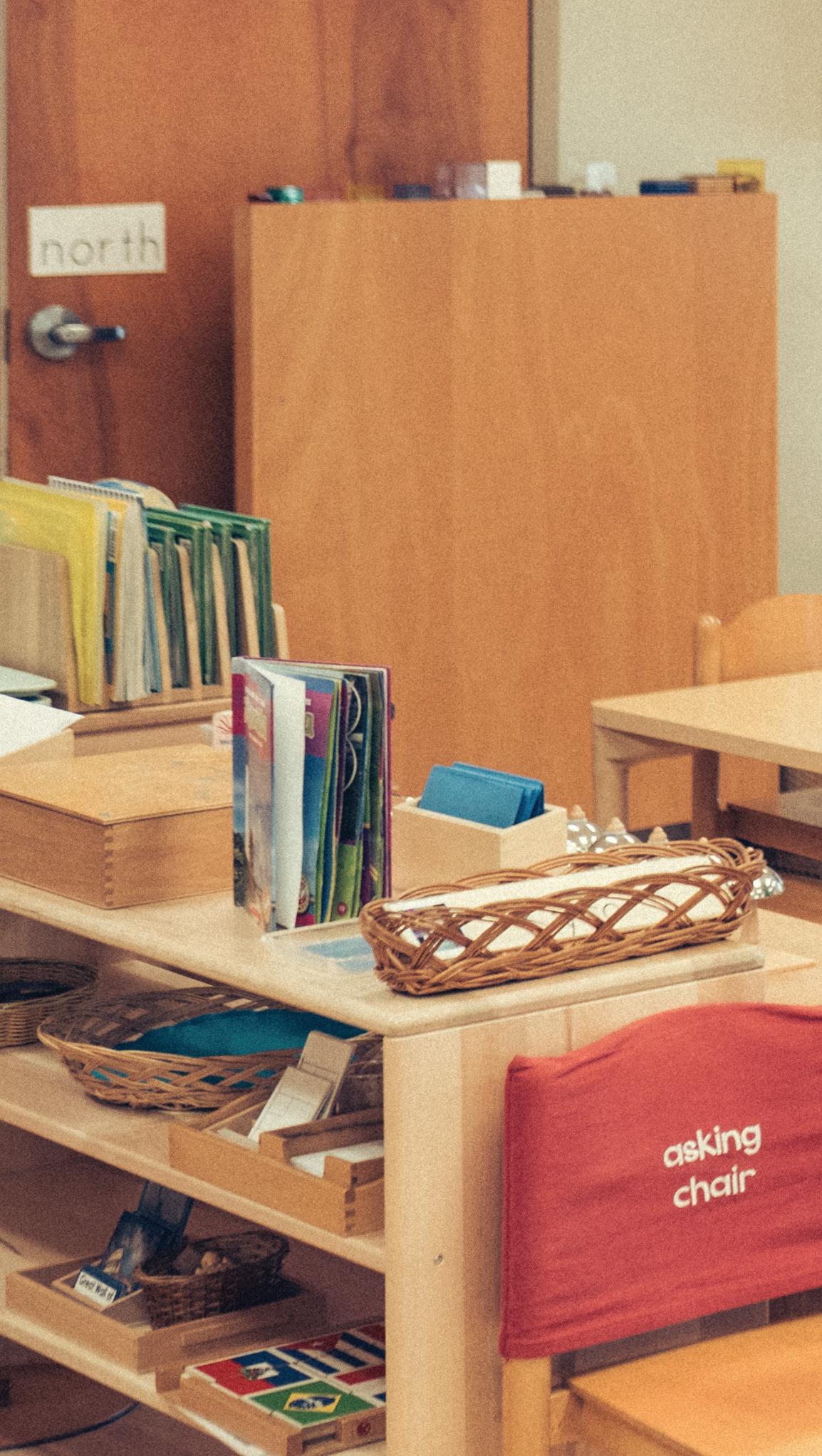

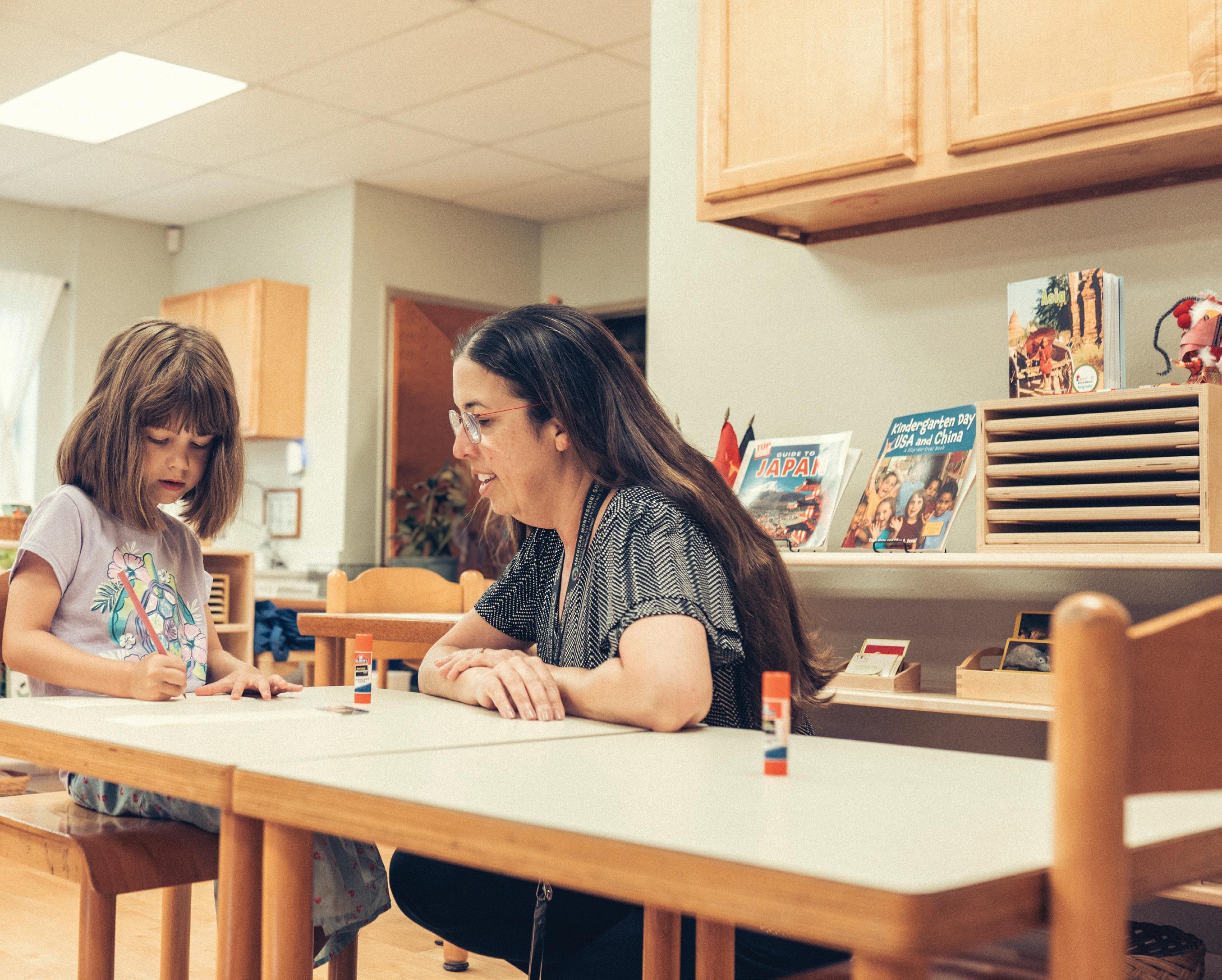

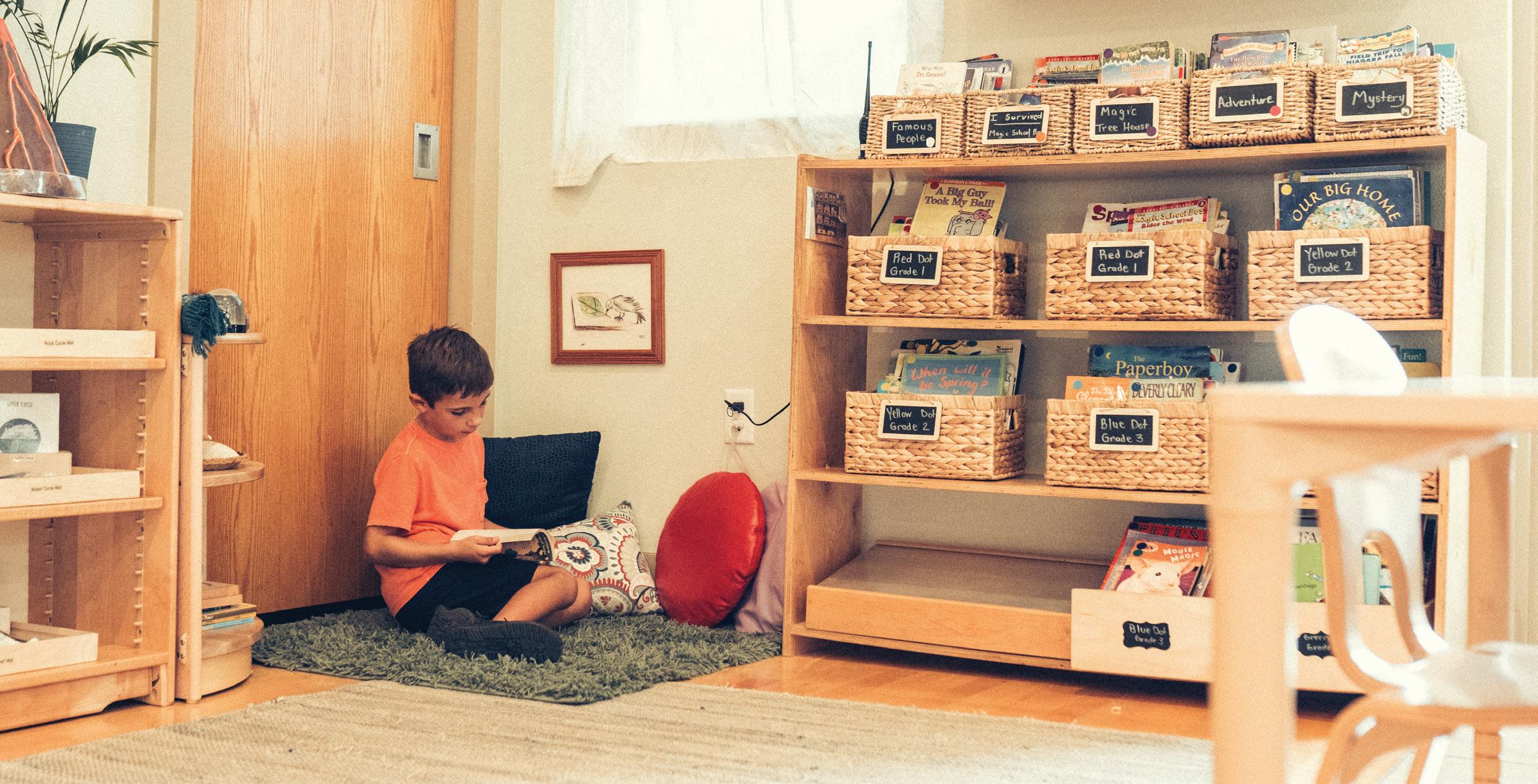



WRITTEN BY RJ WALTERS | DESIGNED BY ELIZABETH PEREZ-LIBRAN
PHOTOS PROVIDED BY POLK COUNTY PUBLIC SCHOOLS
Life isn’t all about accomplishments, but sometimes, especially when it has been a grueling toil to get there, you can’t help but celebrate and tout your achievement a little bit. Fred Heid, Superintendent of Polk County Public Schools, doesn’t act like a “B” school grade from the Florida Department of Education is the pinnacle he is trying to lead one of the largest districts in America to, but he’s OK with stopping at the summit to acknowledge all the hard work it has taken to earn the first “B” for PCPS since 2019.
In a district where the number of industry certifications earned by students is skyrocketing there is a palpable sense that positive momentum that has been built can be the catalyst for even stronger returns such as improved early literacy scores and graduation rates in the near future.
But work remains, and Heid and his leadership team is prepared to keep proving the value and staying power of public education. As the 2025-26 school year kicks off, we had the opportunity to sit down with Heid to discuss School Grades, vouchers and what excites him about the future.
The conversation has been edited for length and clarity.
THE LAKELANDER
If this were a State of the Union, how are you feeling as the school year gets kicked off, about the trajectory of the school district with all of the variables and intangibles that everyone likes to talk about?
I’m excited about this school year…for several reasons. This last year showed that our growth has not been isolated to one or two years—It’s been a consistent pattern, a consistent positive trajectory for the last four years. So as we go into year five, the district grade of a
“B” does a lot to reinvigorate our organization. Schools can and teachers can be proud of the work that they continue to do, and that… it’s resulting in outcomes for our kids. I think for our community, the district grade is a big, big indicator and a positive indicator of how successful and healthy our school district and school system is. They can be confident that when a kid walks across the stage, they’re actually graduating—they’re not just getting a certificate of completion. The one piece I would really highlight is that out of the 14 components that the state uses to calculate a school district grade, we improved in 12.
TL
What does it mean to be a “B” district and what does it not mean?
FRED
It doesn’t capture the intangibles, right? It doesn’t capture the realities of many of the barriers, real or perceived, that our kids face on a daily basis when they come to school—whether its nutritional needs, household issues, poverty— all those things are very real. What the school grading system does not capture…is the empathy and the relationships that our staff build with students that nurture that support and help us overcome those deficiencies or barriers for kids so that they can continue to be successful. We minimize disruptions, we minimize fear and we create opportunities for kids to thrive in an environment they may otherwise not be able to experience.
The other thing is it doesn’t capture the individuality of every student…it has a very limited myopic kind of assessment of students’





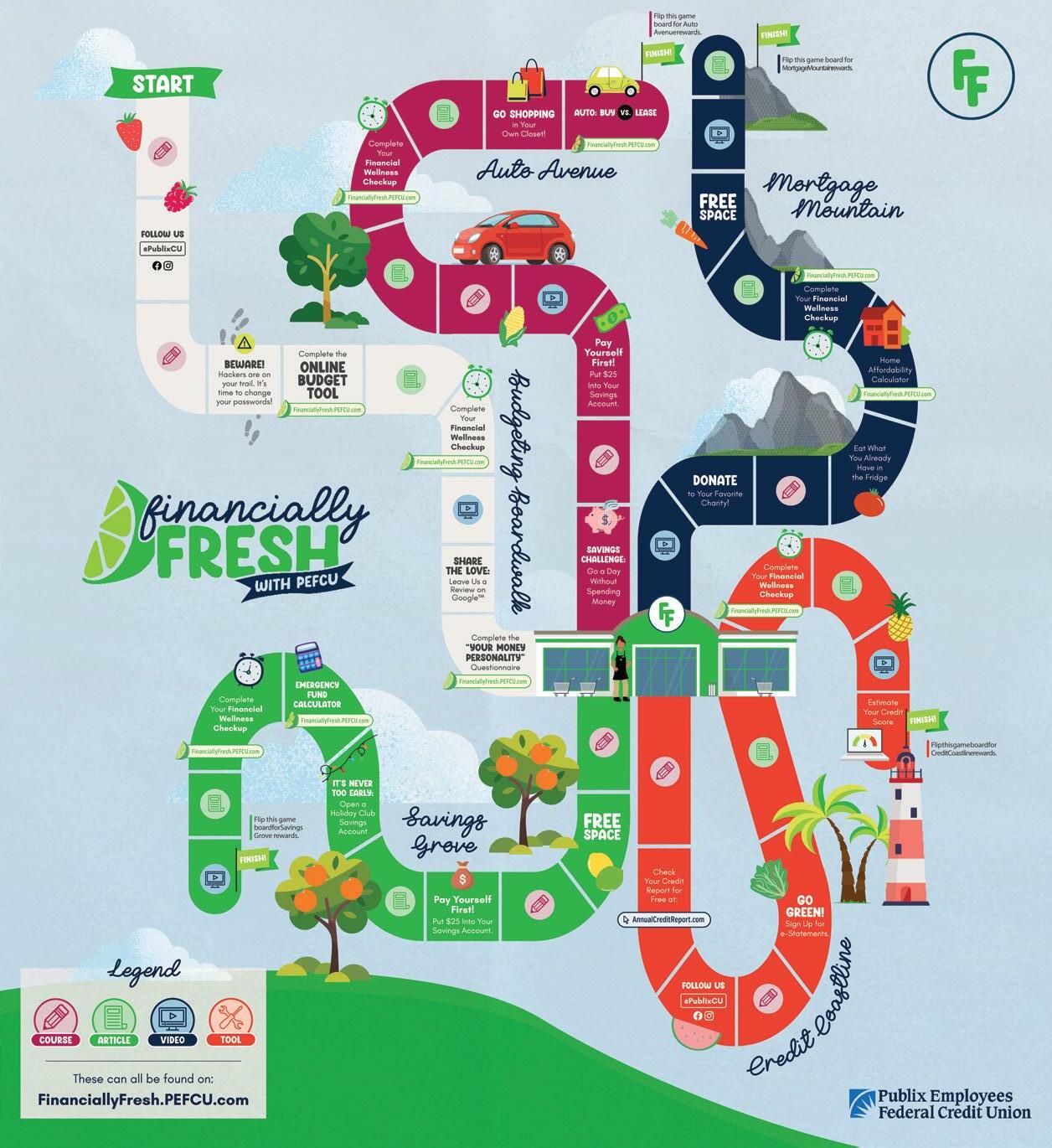

academic performance, but it doesn’t measure their personal growth, their emotional development, their workforce readiness, some of those things. You could make an argument that acceleration captures some career tech ed and workforce...but it really doesn’t capture the whole child. I think we’re very proud of the “B’ but quite frankly, if you were to ask me, we’re an “A” district all day, every day because we do great things for kids.
TL
Nothing is static about education, not even how school grades are determined. With more “A” and “B” schools and districts throughout Florida, it appears you might have to work even harder to get the same “B” grade—am I right?
FRED
It’s very true, and thank you for acknowledging that. I believe it’s a rule or statute that says that when a certain percentage of schools earn an “A” or “B”, that the state then has to modify [the scoring scale] and make it more difficult. Conceptually. I understand it, right? I’d be lying if I didn’t say I get what they’re trying to do with that. And if we weren’t talking about children, if we were producing widgets or manufacturing something, maybe that makes sense. I think the struggle that myself and other professional educators have is the score is the score. You know, it feels like for those of us who are in education and for anyone else, you remember 90 to 100 is typically an “A.” And now we’re saying, well, too many kids are passing and doing too well, so now we’re gonna make it 95 and above as an “A.” I understand why, I just don’t agree with doing it right now. I think we should wait a couple
years and make sure that the results that we’re seeing are consistent…and I think there should be a little bit more conversation around that issue because that system was developed [more than 20 years ago].
And you know, my job is not to make excuses, my job is to make sure we get the kids there, and that’s what we strive to do each day. So it’s a hard question to answer—I mean, we’re talking philosophy versus pedagogy.
TL
“I THINK WE’RE VERY PROUD OF THE “B’ BUT QUITE FRANKLY, IF YOU WERE TO ASK ME, WE’RE AN “A” DISTRICT ALL DAY, EVERY DAY BECAUSE WE DO GREAT THINGS FOR KIDS.”
I recently read an article in The Ledger that talked about data from the Florida Policy Institute looking at Step Up for Students state voucher dollars and the dollar amounts and percentages of growth we may see in the state, and even Polk County, in the future. As you continue to advocate and work for the students of Polk County, if you’re at the table with other superintendents or you’re talking with legislators and trying to impact change, how do you navigate the voucher dilemma in terms of what you believe is a good long-term solution that allows for the freedom of choice in the education system but also recognizes taxpayers fund public education?
We’ve been talking a lot about this, and I have said publicly already that my job is not to stand in the way of school choice or options, but it has to be regulated. I think the frustration can best be explained if I give you the example of what just took place. At the end of each year, every school district works with the Department of Education to basically project what our enrollment’s gonna be in the subsequent school year, and there’s a lot



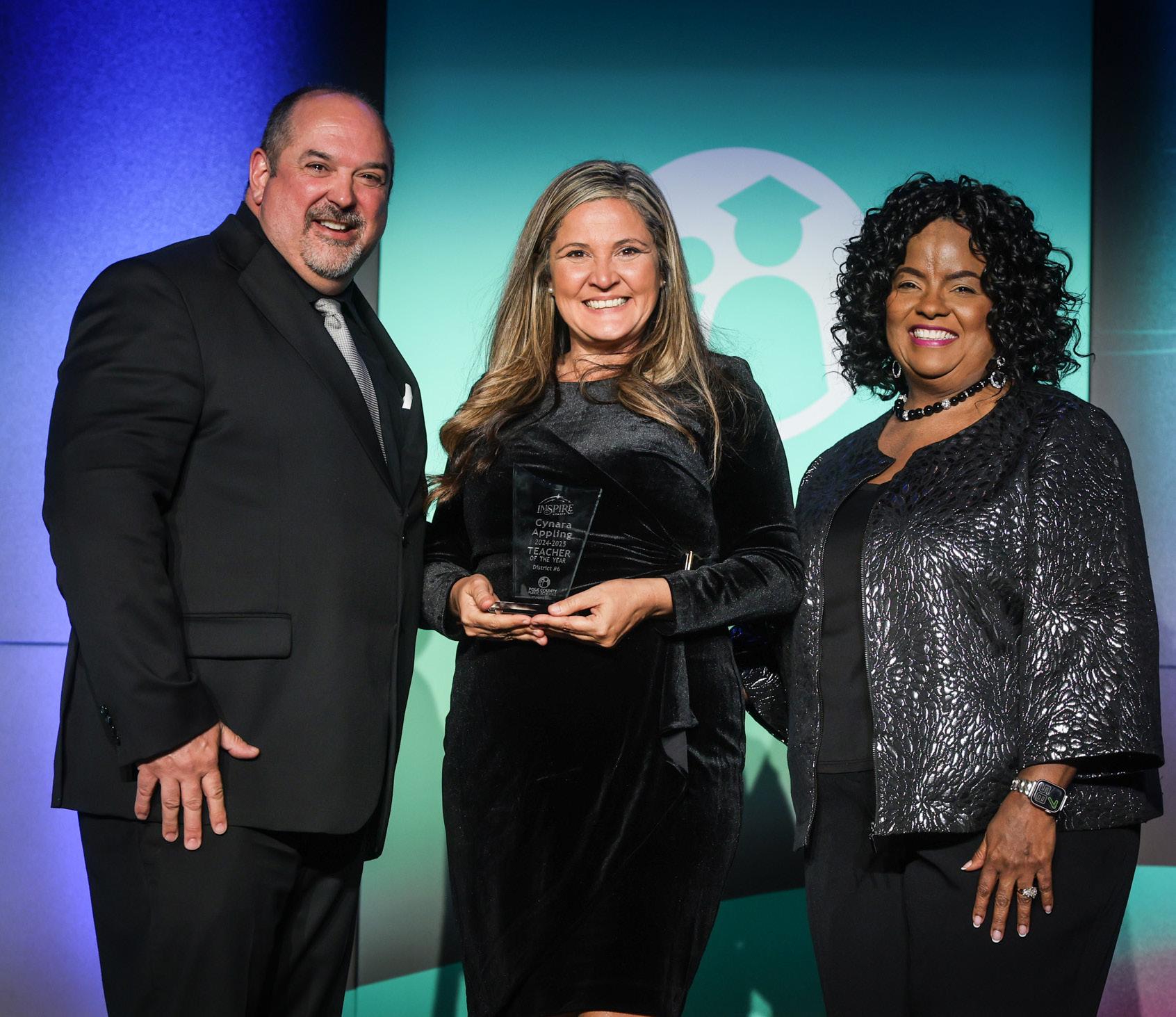
of different ways we do that. But the one piece we don’t provide and the state provides is the number of students who are gonna get a scholarship or a voucher. Last year…we had 11,040 kids on vouchers. And going into this school year, when we did our initial budget projects and submitted everything to the state, we were [told we were] going to see an increase to about 13,100, so an increase of a little over 2,000 kids. The reality was that they turned around and told us what it actually is, and it’s 17,000. The issue isn’t that the number jumped, the issue is that the number changed so late in the summer and did not give us the opportunity to adjust our fiscal situation. Now I have to wait until the first two weeks of school are over to determine how many of those kids actually came, didn’t come, those kinds of things that we can adjust our staffing, and that’s not really appropriate because I would’ve preferred that to have been done over the summer.
What I am suggesting and what I am proposing is that the state continue to honor scholarships, they continue to allow annual growth in a number of scholarships. If that’s where parents want to go and where they want their dollars to go, fantastic, you know, we’re here to compete. But at the end of the day, what I would ask for, it’s just a more reasonable way to budget and plan for it.
We’re all about choice and I think the fact that overwhelmingly parents are choosing public schools, including Polk County Public Schools, continues to demonstrate that trust. So we’re here, and charter schools are here, private schools are here, scholarship students are here…and I would hope that the legislature remains open to continually tweaking and refining this process to make sure that we’re doing the right thing.
TL
You make it a priority to be out in public having conversations with as many people in as many different communities as possible. What are some of the key things people can expect to hear you talking about this school year?
FRED
That we’re not done until 100 percent of kids graduate, 100 percent of our kids can read on grade level and 100 percent of our kids can do math on grade level. We’re not done.
We’re excited, we’re thrilled, we’re pleased with our progress, but you know, it’s kinda like the old Janet Jackson song, “What have you done for me lately?” I’m gonna celebrate what we’ve accomplished, but I’m gonna reassure people that we’ve got a long way to go and we need their help. We need their support. And, you know, it’s only together that we’re gonna move to that next level.
Really three things are keeping us from being an “A” district. Number one, we need parents to help us with chronic absenteeism and truancy—you can’t learn if you’re not in school. Number two, we need parents to really be engaged, read with their kids, stay abreast of their schoolwork—you know, be a partner with the school and your child’s teachers. Don’t be a passenger in education.
And then the last thing, as I mentioned earlier, we just have to [improve] our math scores in ninth grade, but that’s not a ninth grade teacher issue. This is not a commentary about ninth grade math teachers because math proficiency starts in kindergarten and or even earlier than that, it starts at home. We’ve gotta figure out what’s happening or not happening. And, and my personal view is I think we allow students to develop this perception that they’re not good at math, so that becomes the excuse, and that’s just simply not true. So how do we overcome that?



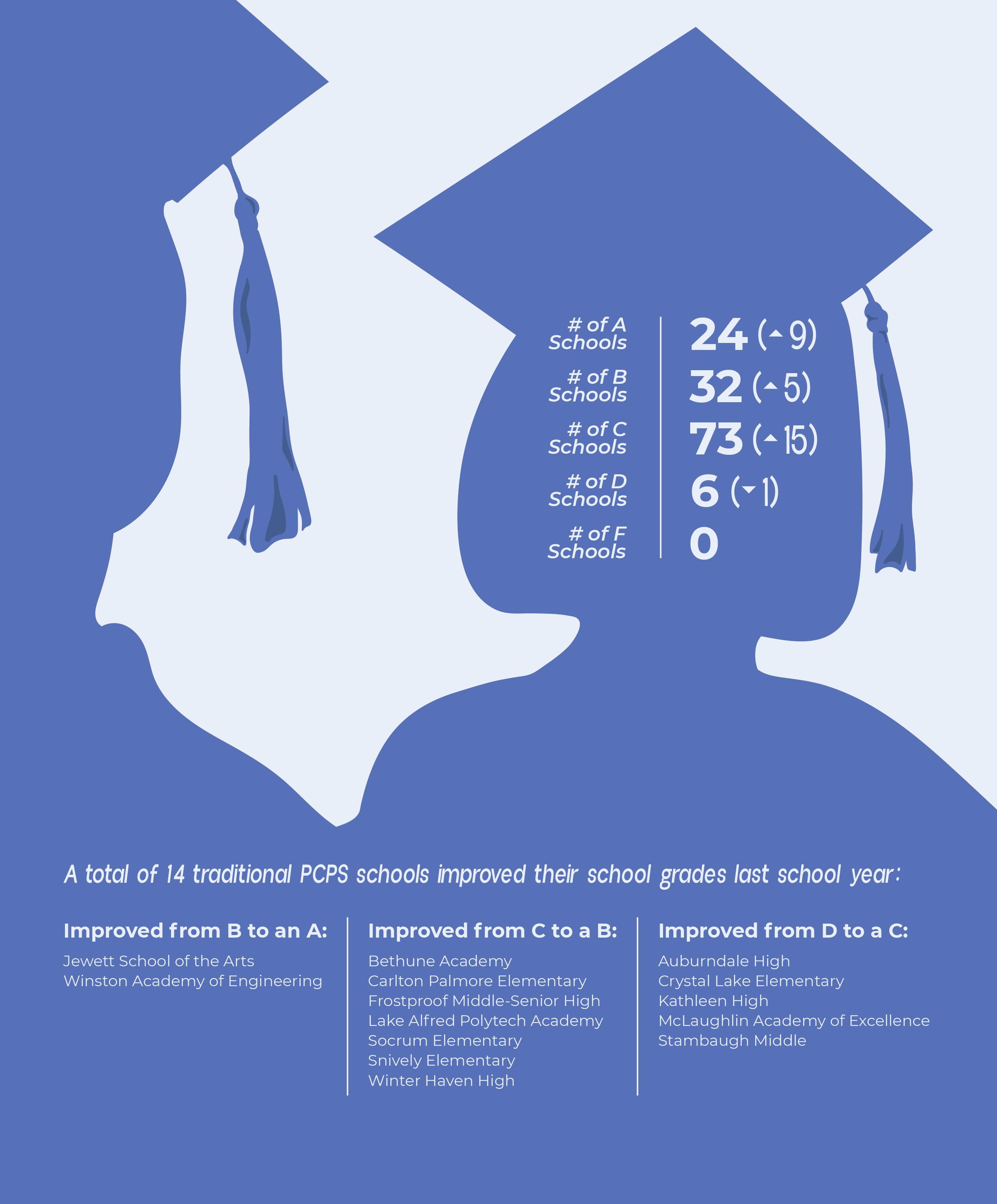
We’ve grown a lot in our 95-year history, but in that time, we’ve remained devoted to our associates and communities. We’re the largest employee-owned supermarket chain in the United States. We’re committed to charitable giving, sustainability efforts, and working to fight hunger. We’re a company that cares. That’s why we’ve been named one of Fortune’s 100 Best Companies to Work For® 28 years in a row.




WRITTEN BY RJ
WALTERS
PHOTOS PROVIDED BY POLK COUNTY PUBLIC SCHOOLS
DESIGNED BY ELIZABETH PEREZ-LIBRAN
ore than ever students want to be immersed. Whether it’s waiting in long lines to be part of large crowds watching their favorite music artist, simulating real-life adrenaline and excitement with virtual reality headsets or dropping hard-earned cash to buy the swag and go to the theme parks associated with their favorite characters, they are looking for something that’s more than just “by the book.”
Beginning in the 2026-27 school year, students in Polk County will be thoroughly immersed in the realities of finance, business and trade work, and have new tools to realize how each of those areas offer possibilities for their futures at The Barnett Family JA Discovery Center at Teneroc High School in Lakeland.
For more than a decade, Polk County students have enjoyed immersive entrepreneurial educational field trips to the Junior Achievement (JA) BizTown and JA Finance Park in Tampa, but this new local facility will be the first of its kind in the nation to incorporate the trades as well, helping 5th and 8th grade students understand potential career paths in six different trade industries.
“Schooling doesn’t just take place in the classroom…it’s a number of things and opportunities and influences that are able to mold a student and get them properly ready to graduate from high school,” said Shauna Dykes, Vice President of Districts for JA of Tampa Bay. “The truth is some of these students don’t have any touch points outside of what they experience through a classroom…so I think the more we expose them [to this type of programming] the greater chance they have of making informed decisions and leaving our school district ready to enter their adult life.”
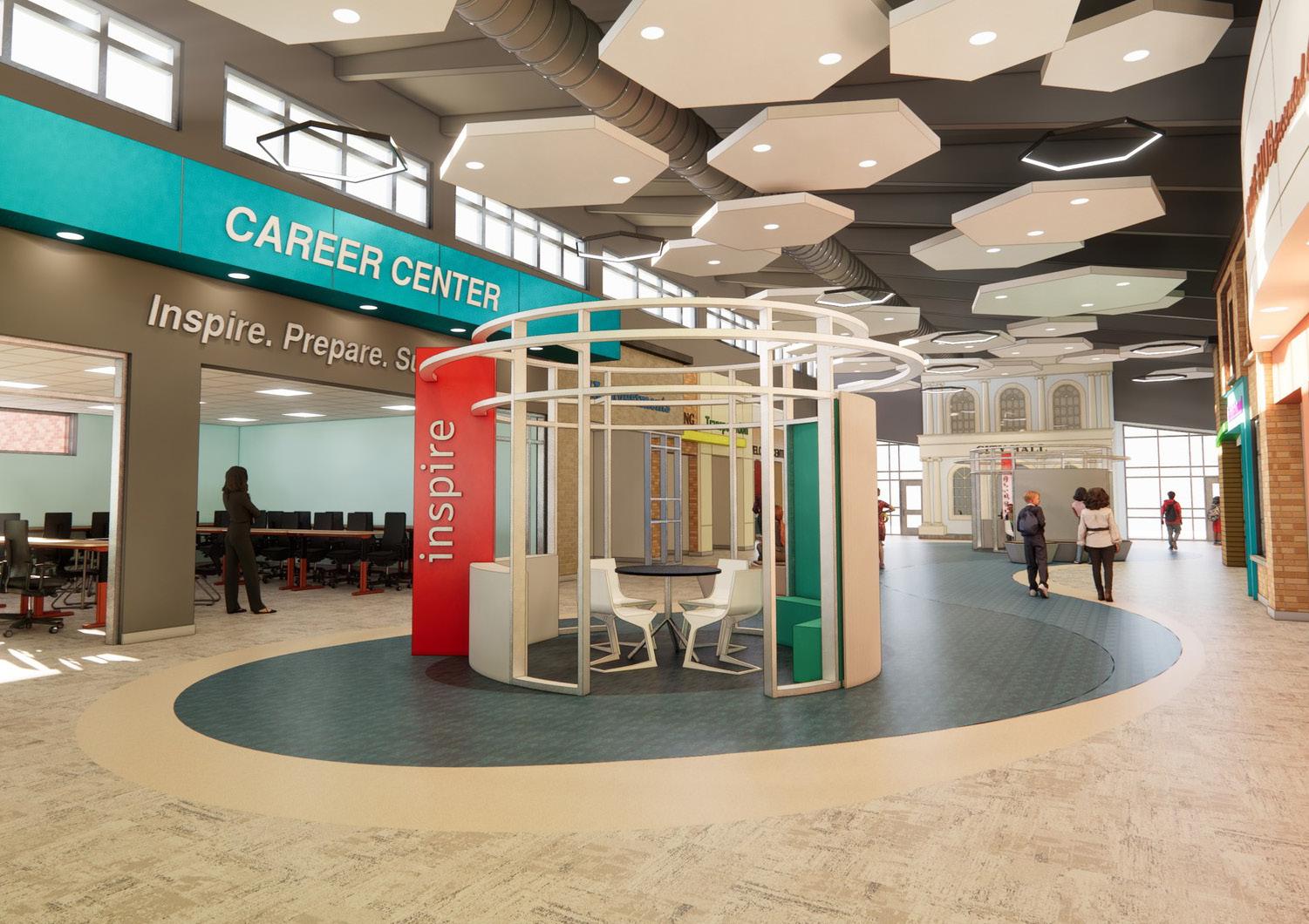
“Schooling doesn’t just take place in the classroom…it’s a number of things and opportunities and influences that are able to mold a student and get them properly ready to graduate from high school,”

It’s a natural and transformative development for Polk County on the site of Teneroc, where the highly-experiential 3DE high school education model has already been successfully implemented by JA.
The 20,000 square foot facility will include simulated storefronts and will look much like a state-of-the-art science and industry center that equates to a lab that simulates reallife “adulting.”
In the BizTown space, 5th grade students will be assigned jobs in industries such as finance, corporate business, healthcare and food service. They will engage in mock interviews, be assigned tasks for the day and earn “currency” they will be able to spend on lunch options and in a retail space. By the end of a trip to the Discovery Center, students should have an understanding of career building, earning, saving and spending.
Sykes said a visit to the Finance Park for eighth-graders will be like a real-life production of the iconic board game Life.
“Students will be assigned a random life scenario including credit scores, a salary, whether they have a family or don’t have a family…and they have to balance a budget based on that scenario, and they may even have student loan debt and those kinds of things to budget for,” Sykes said.
Students will be confronted with real-world decisions like buying organic vs. store brand food, housing costs, car loans and more.
As part of the Finance Park experience, pre-teens and teens will also take a short survey that helps them explore suitable careers and they will dive into trades like construction and plumbing.
The project is the result of highly collaborative efforts of
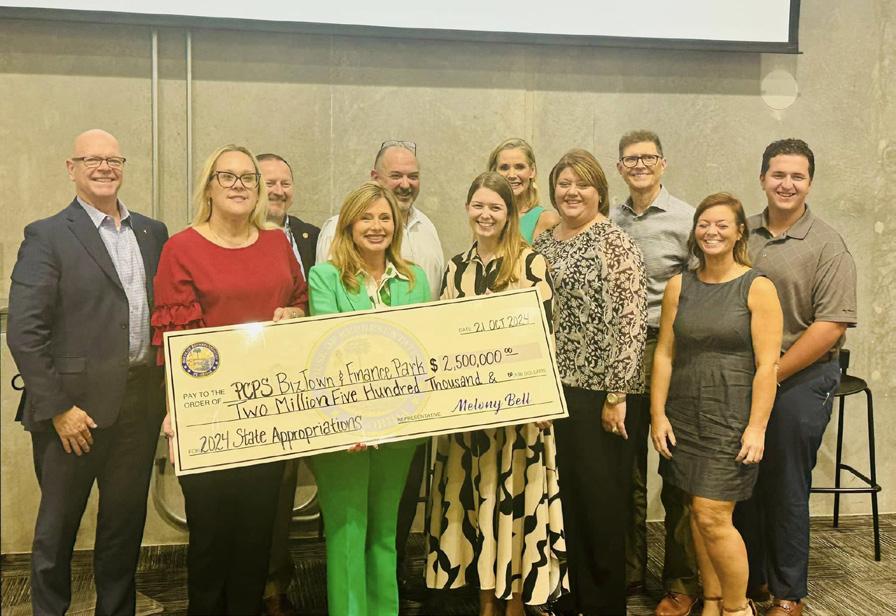
the private and public sector. The Barnett Family made the lead gift in the fundraising efforts, and last October now-Polk County Supervisor of Elections Melony Bell presented a $2.5 million check from the State of Florida that was allocated to the project.
PCPS Superintendent Fred Heid has been a vocal advocate of how the center will empower students and help them develop essential skills, and Melody Rider, President of ConnectED Polk has served as the campaign chair to help bring businesses to the table.
Sykes said the project is currently about two-thirds of the way funded, and entities or individuals interested in investing in it can learn more at japolk.org/ja-discovery-center.
Some of the foundational sponsors include: Lakeland Regional Health, Rodda Construction, Publix Employee Federal Credit Union, YMCA of West Central Florida and Stuart Plumbing Service.
Jason Rodda, CEO/President of Rodda Construction Inc., said they are excited to be part of something that will equip the next generation with the tools they need to thrive.
“As a local contractor, we take pride in being deeply rooted in our community—not just through the projects we build, but the impact we can help to make beyond the job site,” he said. “It gives students a hands-on look at real-world careers, including the many opportunities within construction and skilled trades.”


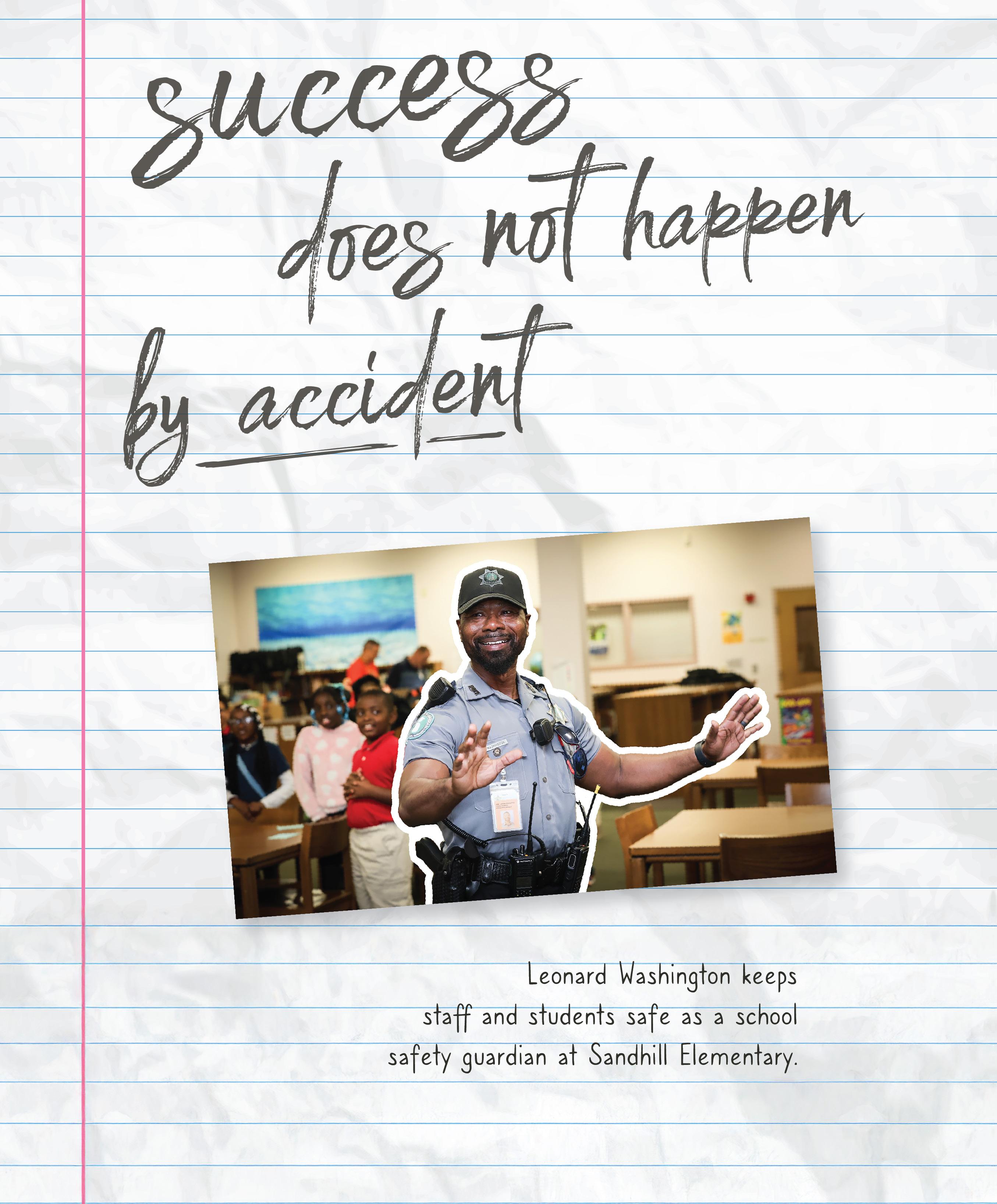



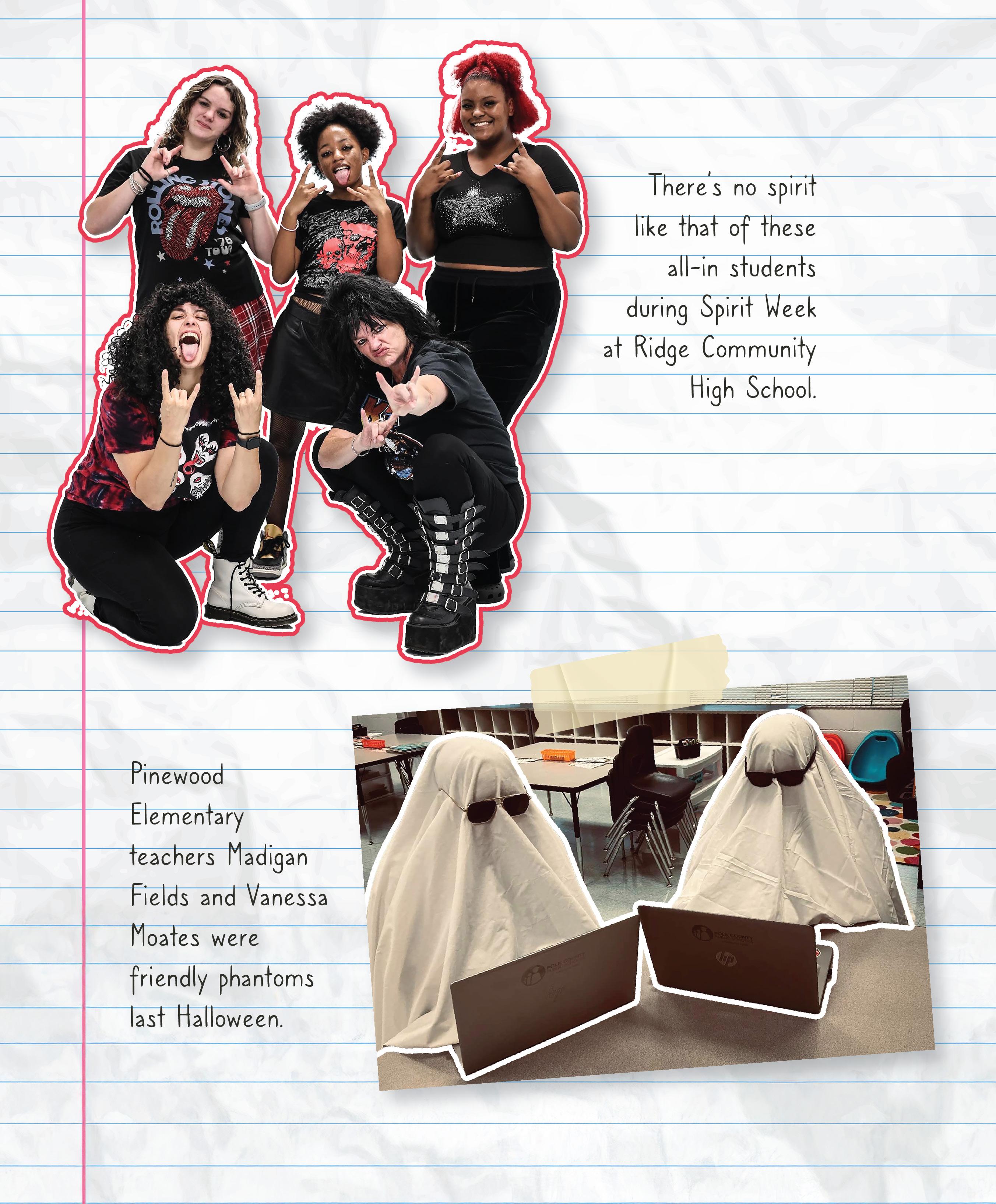



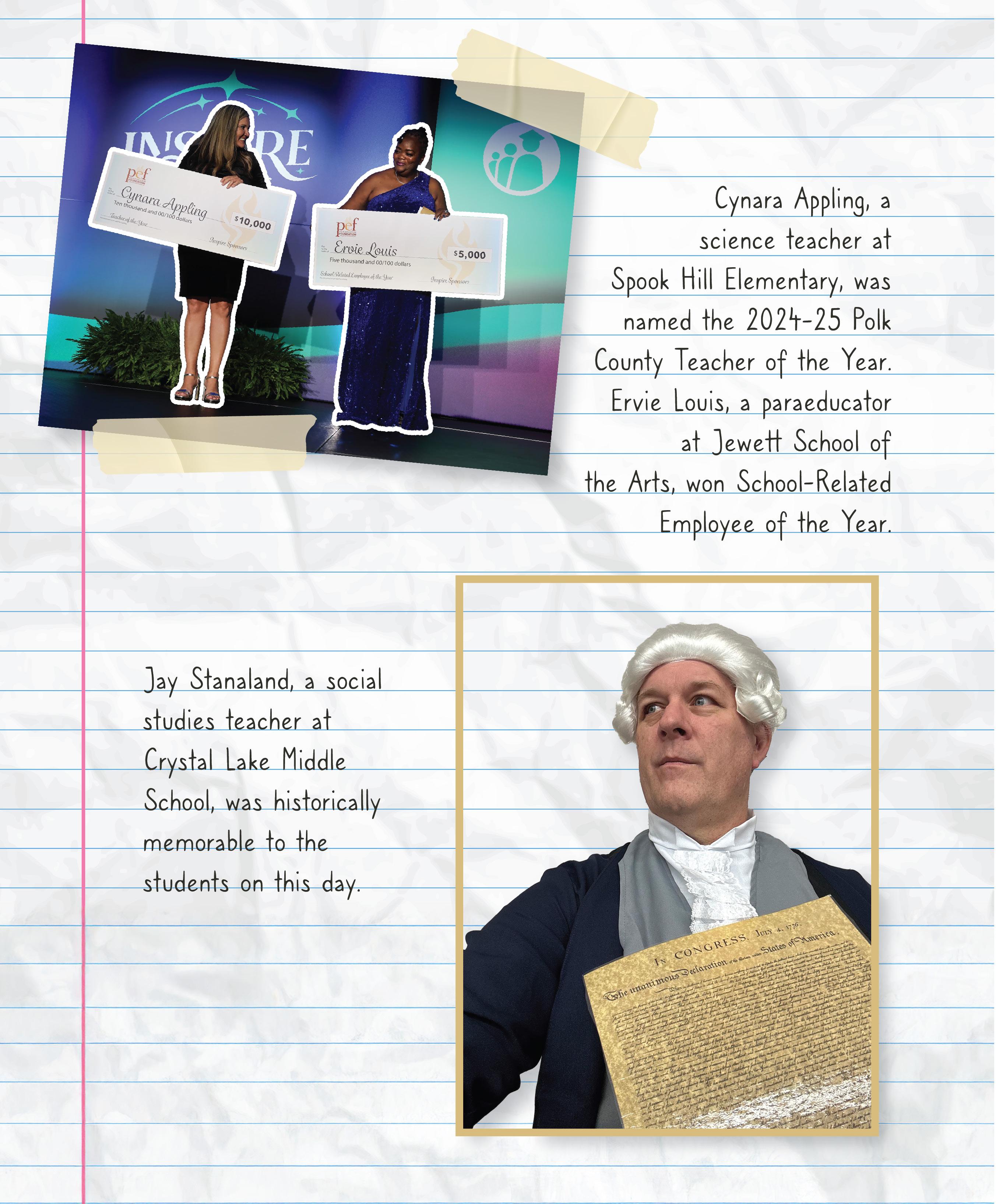
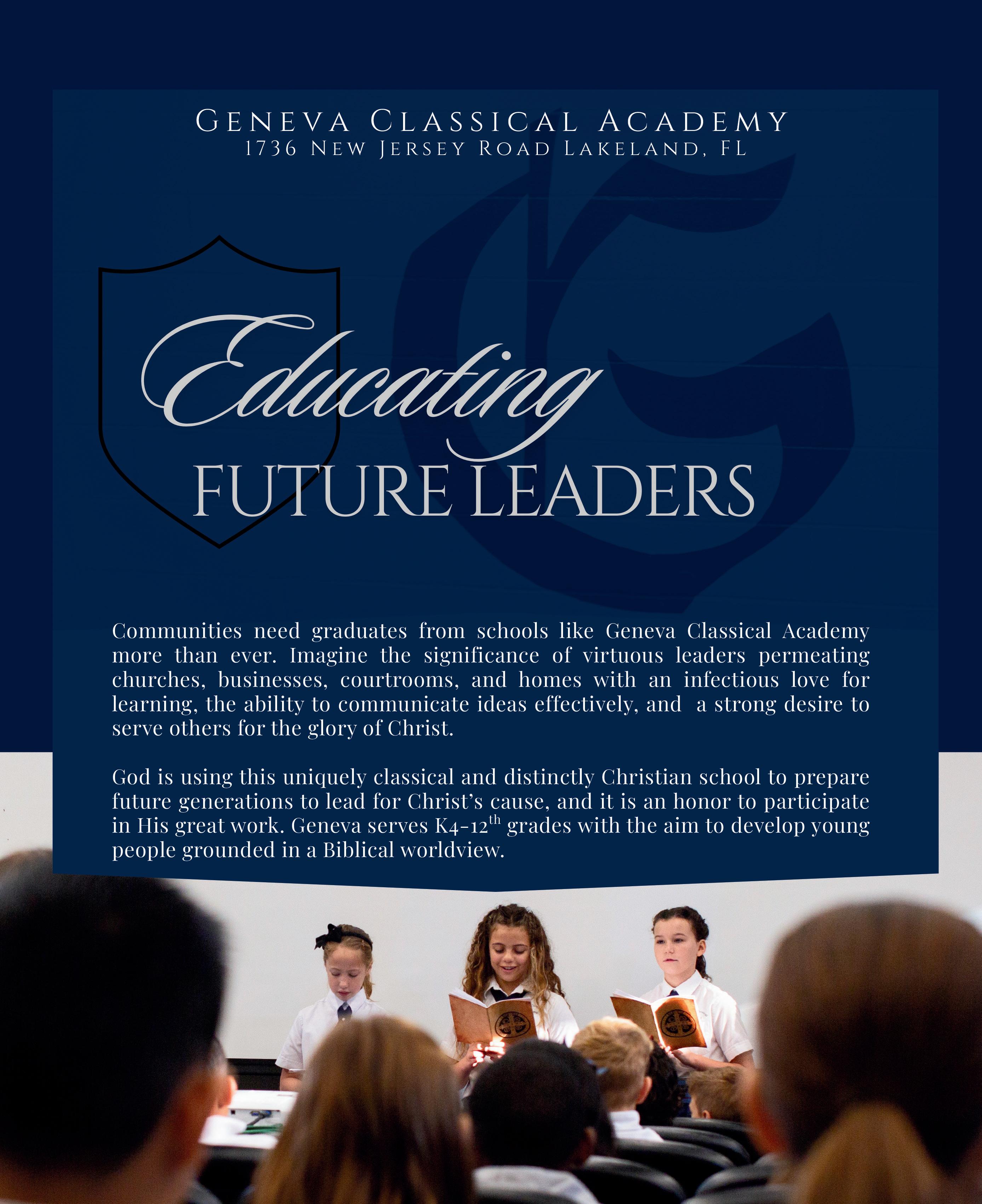

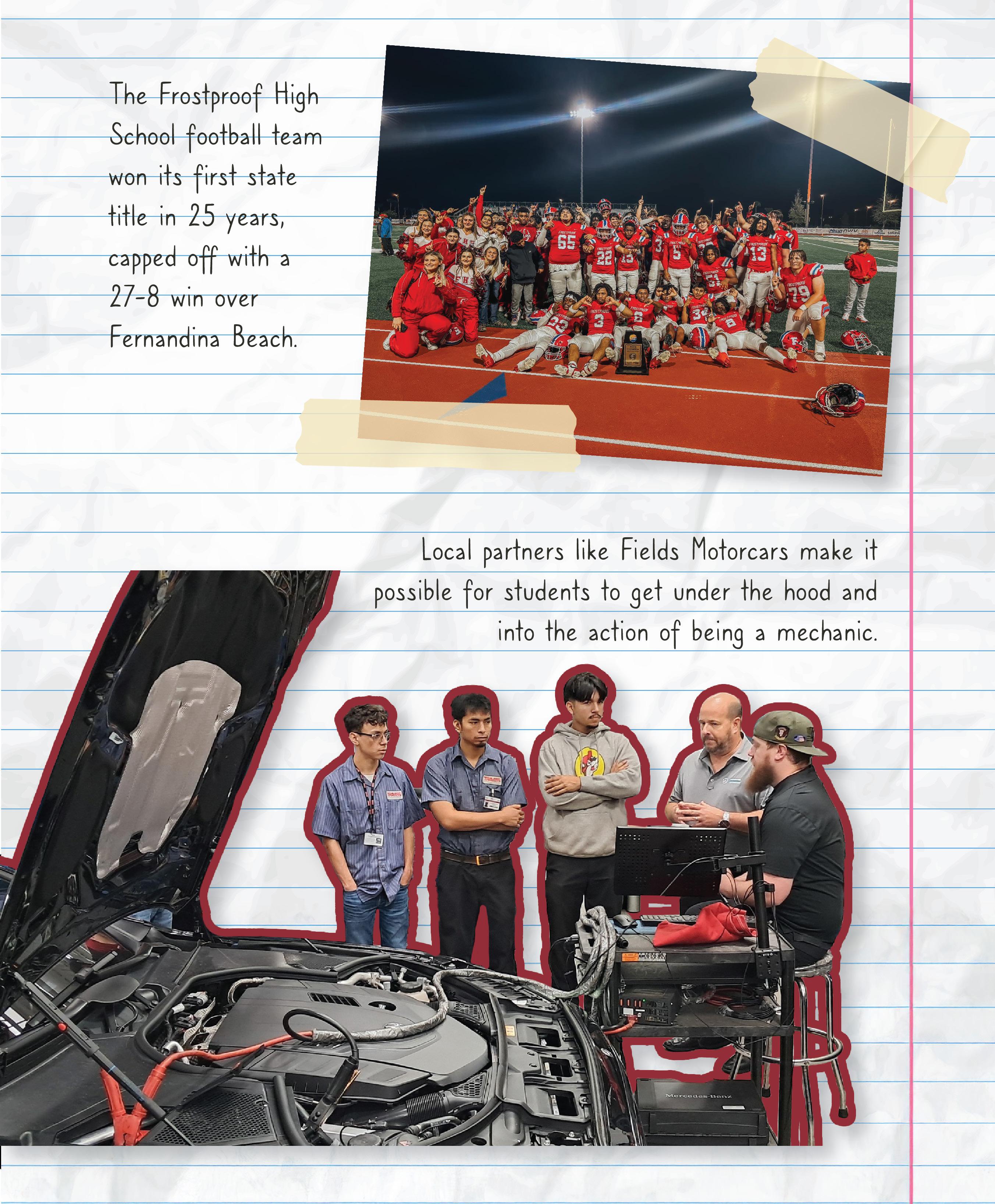
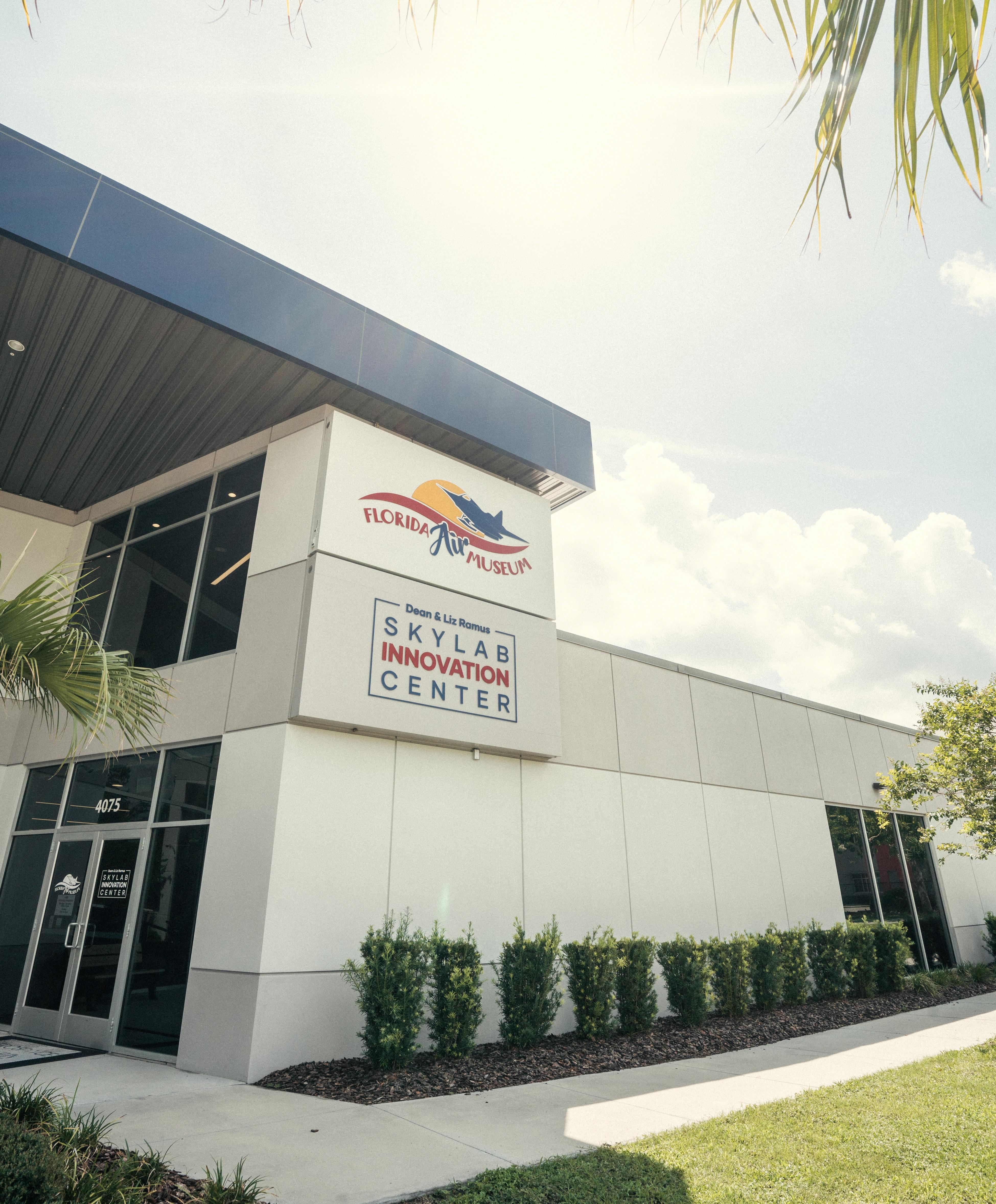
WRITTEN BY RJ WALTERS
PHOTOS BY JORDAN RANDALL AND PROVIDED BY THE AEROSPACE CENTER FOR EXCELLENCE
DESIGNED BY ELIZABETH PEREZ-LIBRAN
Ifyou would have told Eric Crump two years ago that he and his team at the Aerospace Center for Excellence (ACE) would have developed a curriculum that was being utilized at more than 150 schools in 25 states and in five countries, he would have laughed in your face. Just ask him.
Today, he hopes that curriculum will help pliable middle school students realize that careers in aviation are indeed attainable and that their generation will be instrumental in filling what a recent Boeing study estimates as a need for nearly 650,000 new pilots, 690,000 new maintenance technicians and upwards of 1 million new cabin members in the next 20 years to maintain global commercial fleet.
A two-year curriculum developed by ACE staff is designed to help students understand the vastness of the aviation field—as Crump passionately says, “You don’t have to fly or fix airplanes to work in aviation”—with year one introducing students to major areas of technology and year two diving more specifically into aerospace technology.
Crump notes that almost every type of job exists in some form within the aviation industry, so if you’re into marketing for example, why not find out how you can help promote travel for industry leaders around the globe?
ACE’s in-house team of teachers and volunteers has developed content that aligns with the standards of International Technology and Engineering Educators Association and Next Generation Science Standards and can be utilized for an entire school year and count as an elective credit offering.
“When you work with kids, it’s all about self-identification, right? Can I see myself doing this and if I can, then there’s a pretty high probability I’m gonna pursue it,” says Crump, a lifelong aviation and
aerospace lover who started the Polk State College Aerospace program in 2012 and has served as the executive director of ACE since 2022.
“This curriculum really extends us off campus. It lets us get to people literally around the world in a way that we could never expect…[would allow them ] the opportunity to get to our campus.”


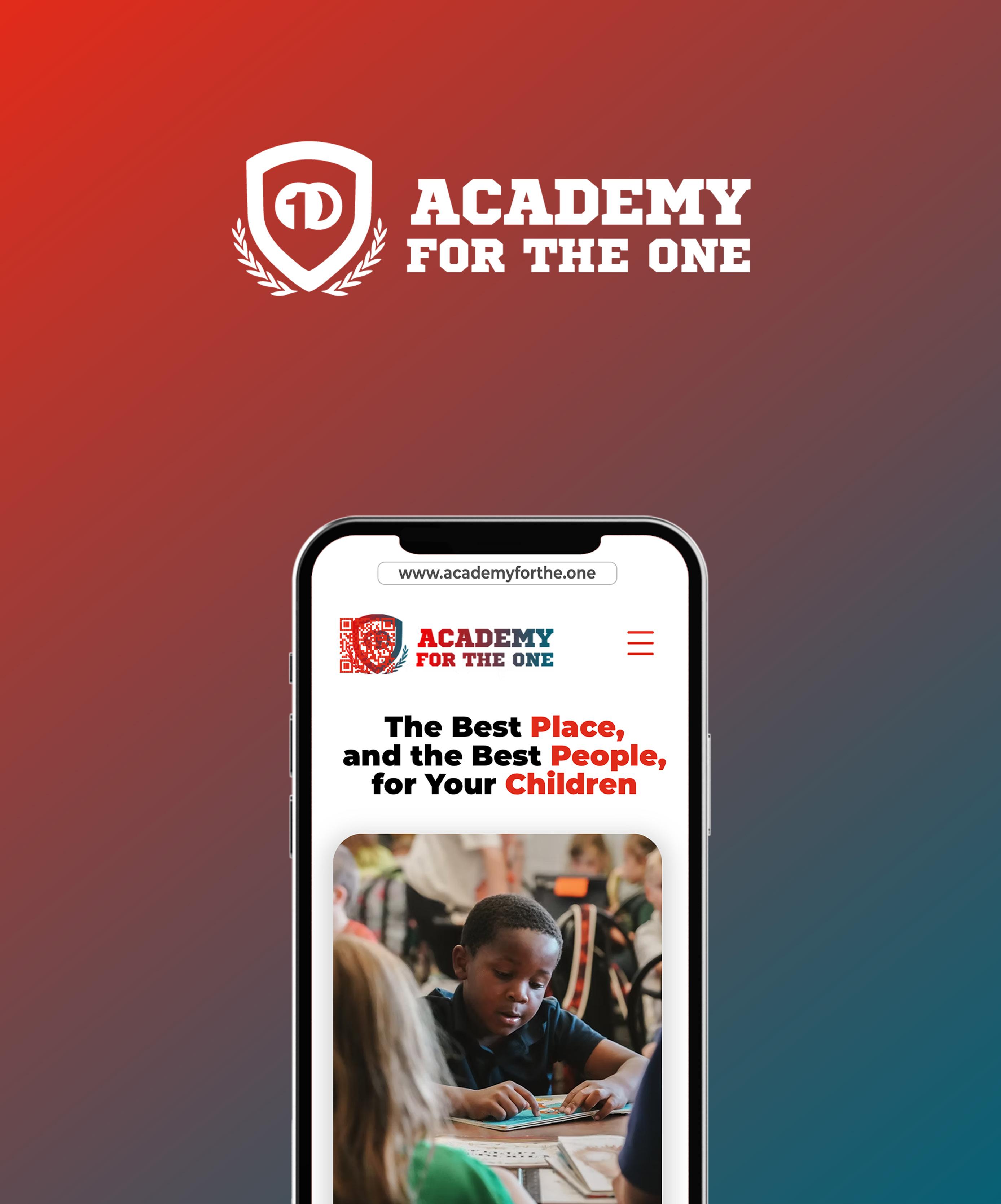

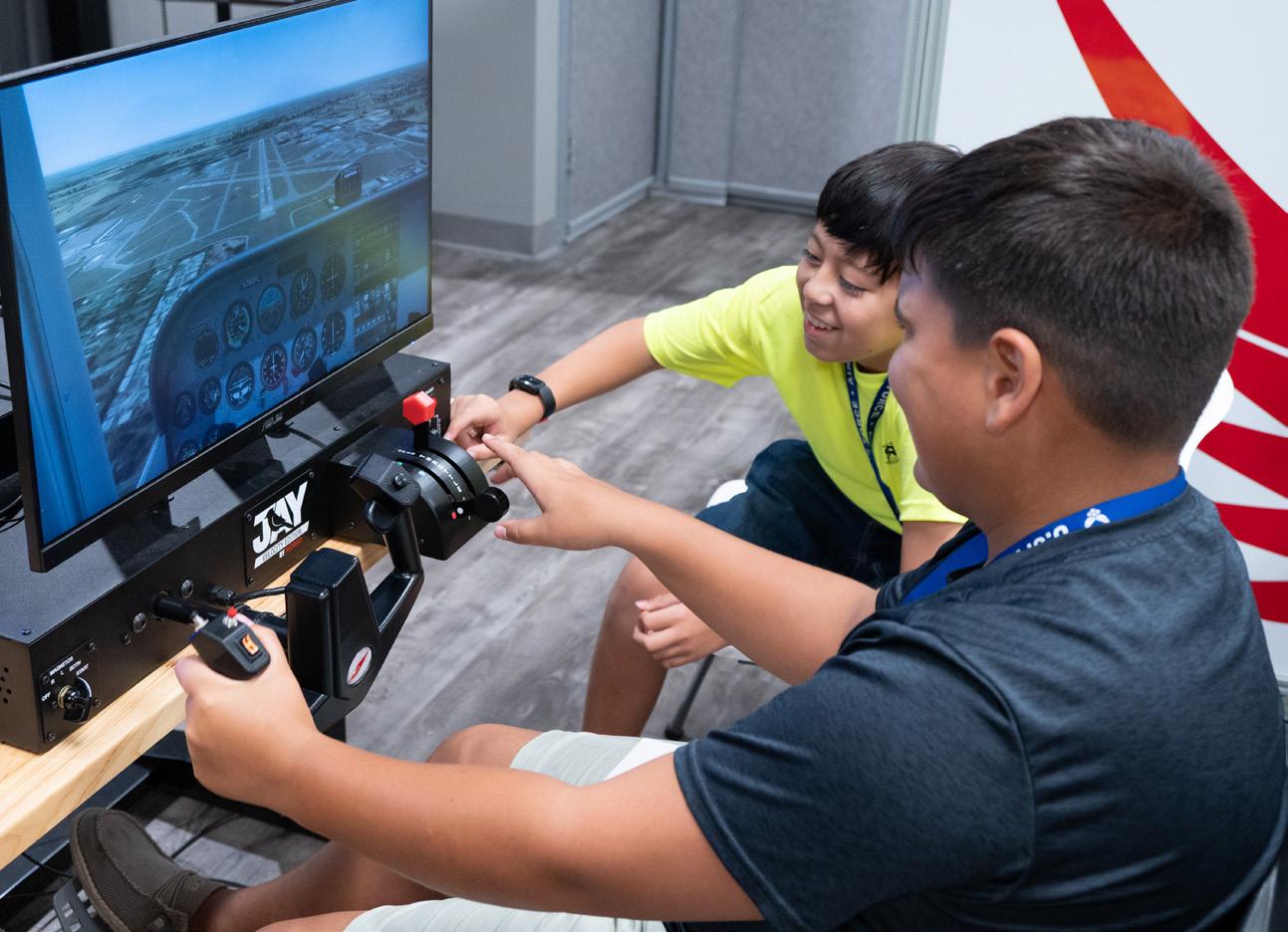
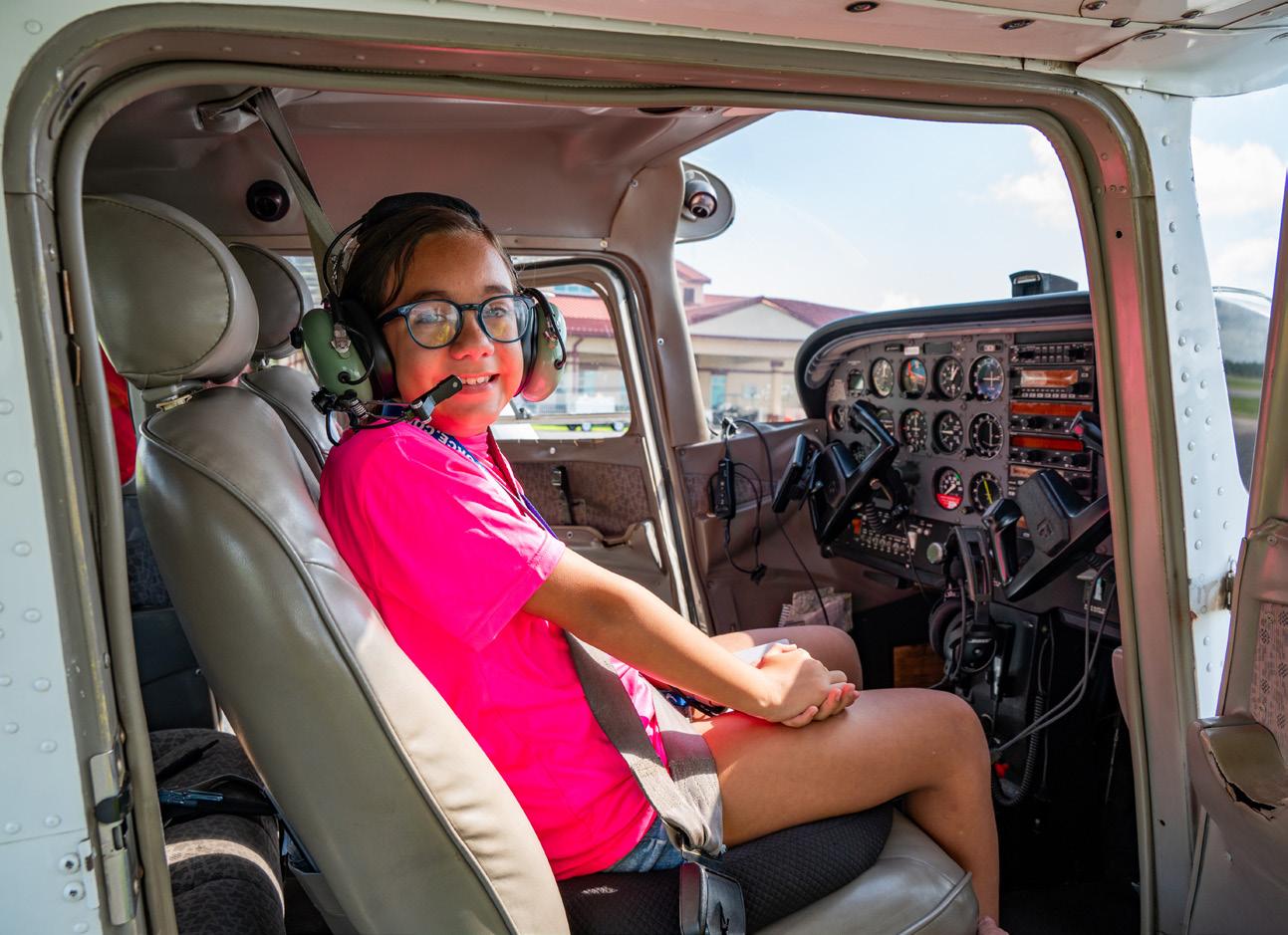
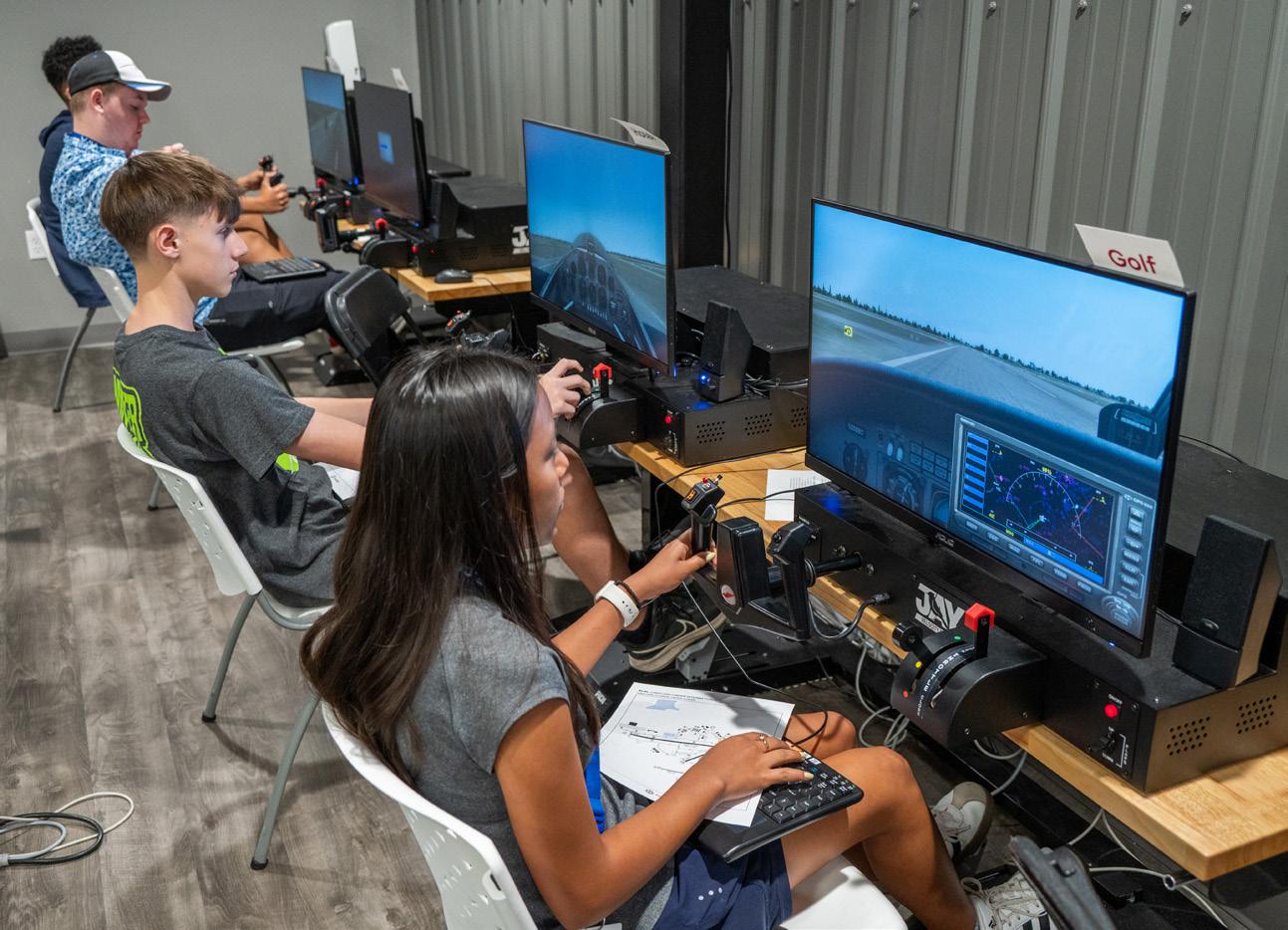
“When it comes to aerospace, I think kids look and go, ‘Wow, that looks cool—I could never do that. I hear kids say that all the time,” Crump says. “And there’s a little piece of little Eric who screams out from inside, ‘Fix him! Fix him!’”
One reason the middle school curriculum has already taken flight at such a high altitude is because of the cost: free.
Access to the curriculum requires a Memorandum of Understanding that addresses legalese such as the fact it cannot be edited, sold or distributed, and partner schools also get access to free professional development for teachers using the curriculum.
ACE beta tested year one of the curriculum with 20 schools and is now set to roll it out en masse while it has a smaller group beta test the second year of content in the upcoming school year.
“When it comes to aerospace, I think kids look and go, ‘Wow, that looks cool—I could never do that. I hear kids say that all the time,” Crump says. “And there’s a little piece of little Eric who screams out from inside, ‘Fix him! Fix him!’”
For those unfamiliar with ACE, in 2014 SUN ‘n FUN launched the center with the grand opening of a 14-building STEM facility that now includes Central Florida Aerospace Academy, a high school career academy, the Florida Air Museum, the Skylab Innovation Center and more.
Through a wide array of classes, camps and student outreach opportunities, ACE works with more than 30,000 students annually, and more than 8,000 tickets to the Florida Air Museum are given away each year. That’s quite the feat for a non-profit organization that relies heavily on proceeds from the yearly SUN ‘N FUN Aerospace Expo, as well as the generosity of partners like Visit Central Florida.

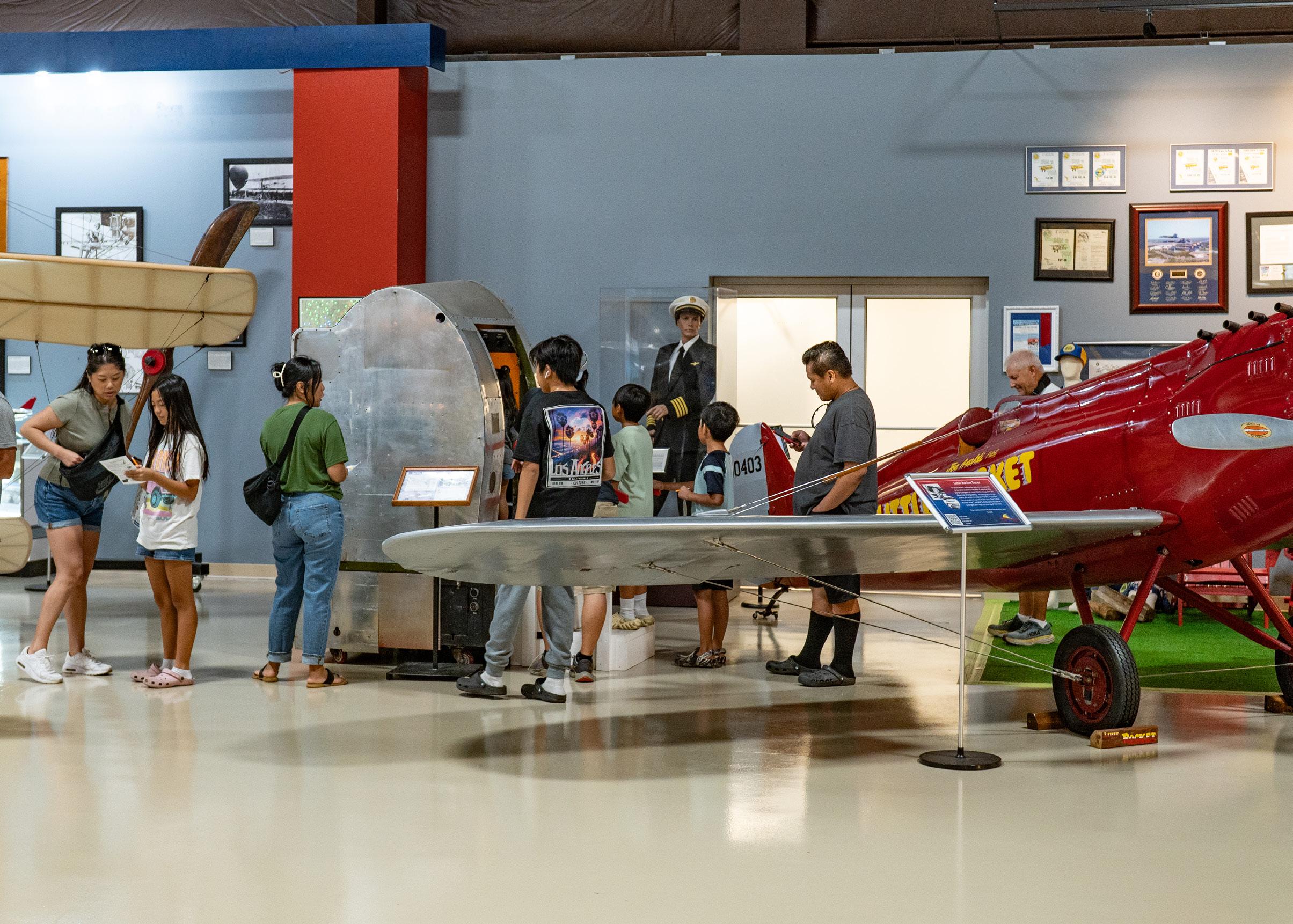
“What we’ve seen over the last three years is that not only locally…but also from the aerospace industry as a whole, people who understand the need to go above and beyond just looking at [funding support] from an ROI perspective,” he says. “This is important and it moves the needle and it uplifts communities, and [gets people and groups who] want to be involved as a partner.”
It’s human nature to look up almost every time you hear an aircraft overhead and people flock to SpaceX launches, and Crump and his team, through this curriculum, want students to go beyond taking video of it on their smartphones and begin to dream of the role they might play in future flights or launches.
“Otherwise it’s a flash in the pan. You’re excited but you can’t do anything with it. That’s the cruelest thing you can do to a kid,” he says. “What we do want them to do is to understand what the aviation industry is and to determine if they think they have a place in it.”

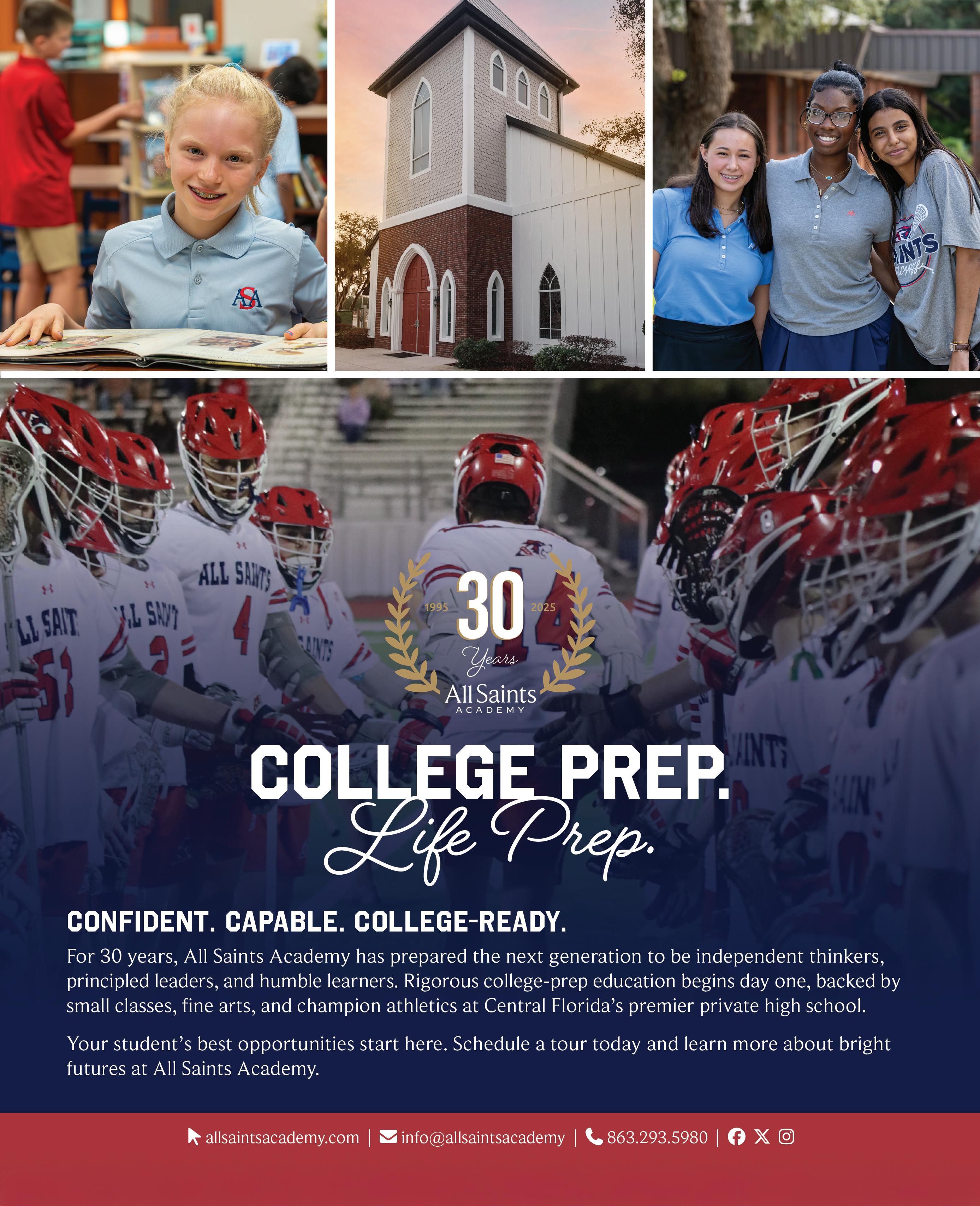
Colton Swartz stepped up to strike a birdie putt at the NCAA Division II South/Southeast Regional following a severe weather delay, first-year—and interim at that point—head coach Brian Richey’s stomach was churning.
The Moccasins needed a top seven finish to qualify for the National Championship tournament, and after several strong days at Mission Inn Resort & Club FSC golfers were playing “about as bad as we possibly could” on day three, according to the 39-year-old FSC alum. They were locked into a sudden death playoff with the final spot on the line.
Nonetheless, Swartz, who had a historically memorable season as a sophomore in which he earned Sunshine State Conference Golfer of the Year honors, holed about a 10-footer to defeat USC Aiken and advance to nationals, an achievement that has become an expectation for a Mocs program that has 13 national titles and five runner-up finishes.
“It was a really special moment,” recalls Swartz, a rising junior from Fleming Island, Fla. “It was a lot of pressure, but it was a moment that made us better as individuals and as a group, and I think that was big for us.”
It was a culture defining moment in a season that included the men securing the program’s first Sunshine State Conference championship in 15 seasons and that saw the Mocs come up just short in the match play quarterfinals against No. 3 North Georgia at National Championships and take fourth overall in the country in the stroke play finals.





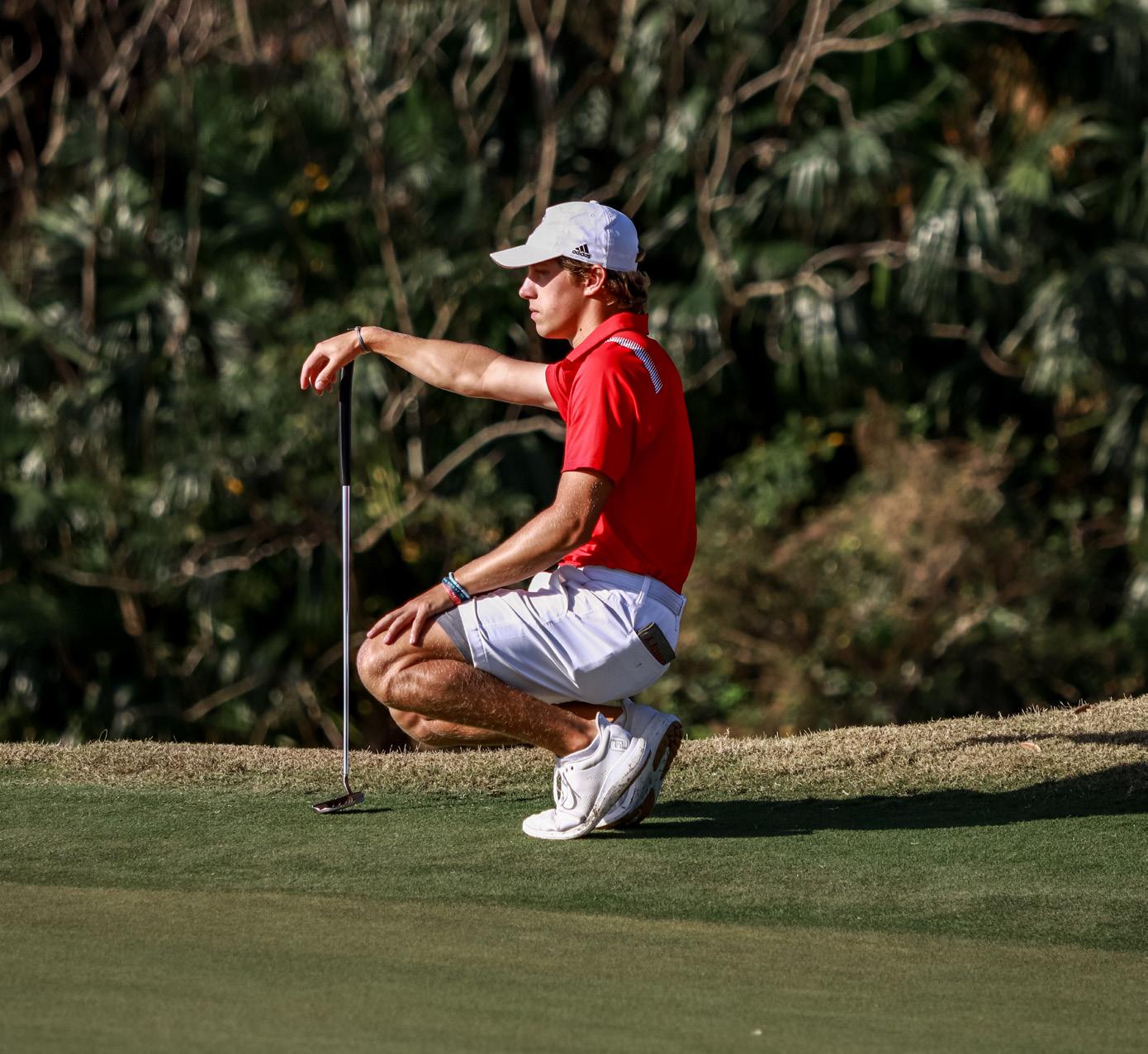
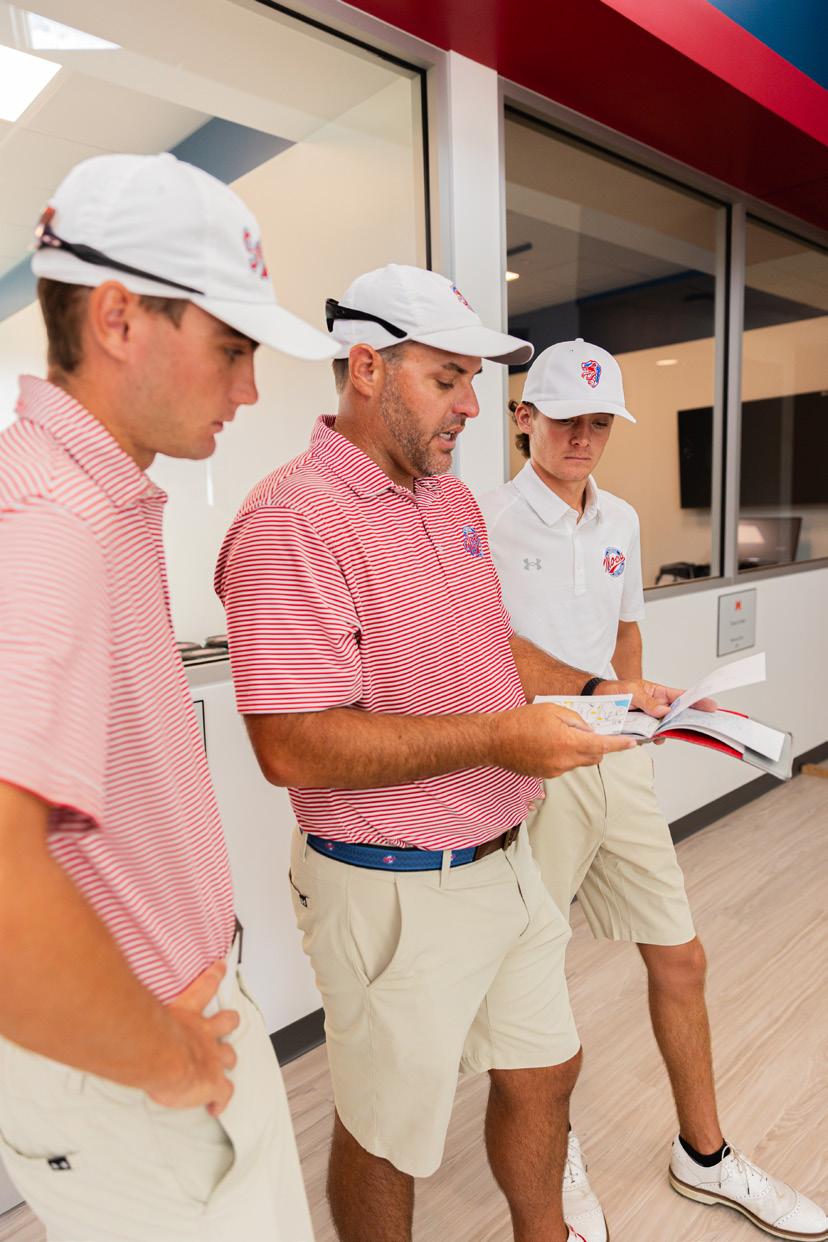
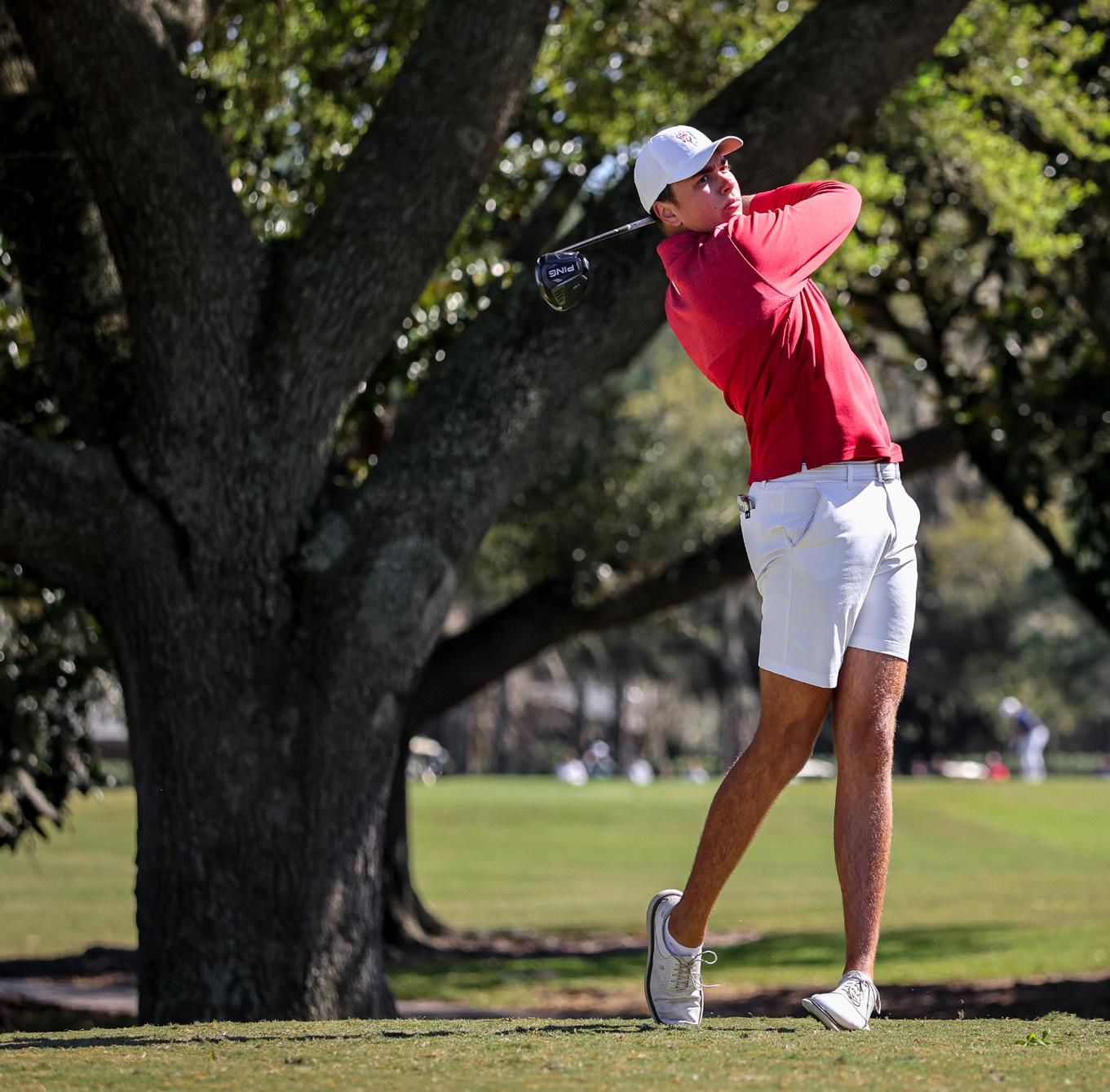



“You know, it’s wild. I think it’s a little bit of ‘pinch me.’ The kids deserve all the credit because I got conference Coach of the Year and I was there for four months?”
For Richey, who played golf for FSC for five seasons before graduating in 2009, it was one of dozens of moments he is now taking time to reflect back on from a memorable and whirlwind season that set lofty expectations for next season that include aiming for the program’s first national championship in nine years.
Richey played professionally on the Korn Ferry Tour, the PGA’s developmental tour, from 2015 to 2022 and notched four top 10 finishes as he chased his dream of playing at the sport’s highest level. Not bad at all for someone who didn’t pick up the sport until about middle school and who humbled himself to the realities of the sport with hundreds of rounds at Cleveland Heights Golf Course where his favorite holes are 6A and 7 because as he puts it, “you can just bomb it there.”
Richey went all in to see how far he could take golf in 2018 when he moved to Ponte Vedra to train more intensely and become a member of TPC Sawgrass. He kept grinding and competing, and even this January he was still dabbling with “What if…” scenarios, but his life looks much different now as a father to two children with his wife, Meghan (also an FSC alum) who he married in 2021.
He had remained close with a number of his FSC golf teammates over the years, including Lee White. As he was hanging with some friends and family watching the College Football Playoff National Championship game he received a message from White, who at the time was the head coach for FSC men’s golf.
“I called him and that’s when he told me [he was stepping down as the head coach] and I was like, ‘You’re doing what?’ just because of the [hard work he had put into coaching the team and] getting the new building, and I had no knowledge of it all,” he says. “He has just had a kid and he told me he had an opportunity that he had to take for his family, and I was like, ‘You know, l’m doing the same thing right now.’ He said he would pitch my
name [to Athletic Director Drew Howard]... and that’s when I talked to Drew.’”
On February 3, FSC named Richey the interim coach. One week later the spring season commenced.
“It was two weeks before our first spring tournament…it wasn’t a mess, but it was chaos for sure,” says Swartz about the impromptu meeting with Howard and White when the former coach announced he was leaving. “I decided to stay and stick it out and see what the year brings…and you know, coach [Richey] is a big reason I stuck it out this year, so I’m looking forward to what we can do next season.”
The first tournament under Richey’s direction was a homecoming of sorts, as the Mocs finished second out of 15 teams in the Matlock Collegiate Classic at Lone Palm and followed that up with a 3rd place finish at the Saint Leo Invitational. The season had its share of ups and downs results wise, but the Mocs led the entire way through the three-round Sunshine State Conference tournament to capture the conference crown. Swartz earned conference Golfer of the Year honors and Richey was awarded Sunshine State Coach of the Year—a trophy he jokes that’s not really his because he was coaching athletes recruited and trained by his good friend.
“You know, it’s wild. I think it’s a little bit of ‘pinch me.’ The kids deserve all the credit because I got conference Coach of the Year and I was there for four months?” he says with a smile, as he looks out onto the Lone Palm course in his new office in the stateof-the-art Lone Palm Golf Clubhouse that officially opened in May. “Drew said in one of the staff meetings [after the season]…Brian, you’re making it real hard to post that job.”
The job never hit the open market, and on



Leader in anterior hip replacement in Central Florida since 1991
Less-invasive surgery for the active patient looking for a quick recovery and a quicker return to work Two Locations
Leader in anterior hip replacement in Central Florida since 1991
Less-invasive surgery for the active patient looking for a quick recovery and a quicker return to work.





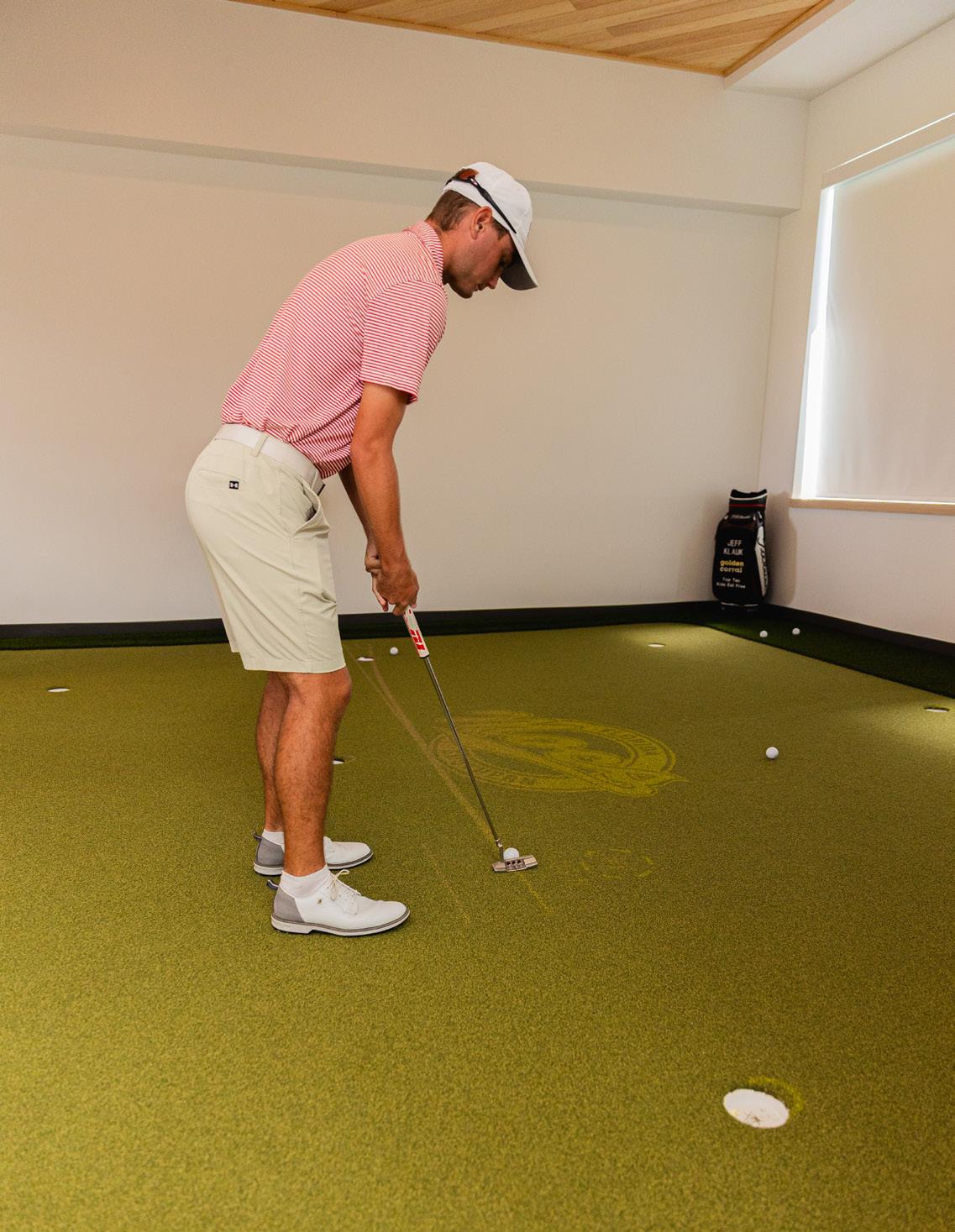
June 5 Richey officially had the interim tag dropped.
“Brian not only understands the prominence of our program but lived it as a player. He was instrumental in driving this team back to the NCAA Quarterfinals this past May, and we are excited to have him continue the rich tradition of our program,” Howard said in a press release.
Lee White’s impact on the program will continue to be felt, especially in the upcoming season as three incoming recruits he secured join Richey’s squad.
One of those, Jack VanderSchurr—who finished Top 50 at the 2024 Florida Class 2A state championships— said White was a phenomenal recruiter, but he’s excited to build on how his new coach and the squad finished last season.
“He’s a great guy with a professional [golf] background, which I think is valuable, and I’m excited because I think we’re going to have a good squad,” VanderSchurr says.
One area Richey is admittedly facing a learning curve is recruiting and understanding the nuances of a collegiate athletics landscape that involves the transfer portal and name, image, and likeness (NIL) money and contracts that can be offered to athletes. He decided to stay put with the recruiting class White brought in for the 2025-26 season, in part because he believes he has the team needed to compete for a national championship, and in part so he can develop his philosophy and gameplan of building and sustaining a competitive team.
Richey and his golfers seem in lock step on the fact that if the players hit their individual goals next season then collectively the team should also reach the promised land it envisions.
Swartz knocked nearly three strokes per round off his average from his freshman season to sophomore season, and he’s been competing a lot this summer in preparation for what he expects to be an even more successful campaign.
“It was just more believing in myself and telling myself I can compete with these guys, and last year I still didn’t know some of the courses so I was relying on the coach and older guys to help me out with where to hit certain shots,” he says. “With the experience I got last year I feel like now I can be a helping hand for the freshman coming in, you know?”
Until the first tee time is announced for the fall season, Swartz and his teammates will be putting in work at Lone Palm as well as the new clubhouse on site that includes two high-end golf simulators, a weight room and dynamic putting green.







In May, FSC held a ribbon cutting ceremony at the new addition to the Moccasins athletics portfolio, Lone Palm Golf Clubhouse.
The 4,000-square foot facility provides a Championship lobby, which displays all 33 titles earned between the men's and women's golf programs, pro-style locker rooms, offices for each coach, two Trackman hitting simulators, a putt view studio, fitness and rehabilitation area, meeting space and a studentathlete lounge.
The facility was designed by John Curtis, CMHM Architects, and built by Register Construction and Engineering of Lakeland.






until it was replaced by a larger building in 1927. The latter building still stands and is now known as the


Since 1948, Peterson & Myers has provided experienced legal advice to help our clients’ innovative ideas become a reality. We believe each client deserves attorneys who create learned, practical, individualized solutions in a constantly changing and complex environment. Please call us or visit our website today for more information about our time-tested legal experience.
